
|
2023 Annual Report of the Minister of Public Safety Concerning Criminal Code sections 83.031 to 83.0391: A Regime to Authorize Certain Activities in a Geographic Area that is Controlled By a Terrorist Group
|
The 2023 Annual Report of the Minister of Public Safety Concerning Criminal Code sections 83.031 to 83.0391 details the ongoing work between Public Safety and partnering departments to operationalize the Authorization Regime.
| 2024-04-19 |

|
Structured Intervention Unit Implementation Advisory Panel 2022 to 2023 Annual Report
|
Second Annual Report (2022 to 2023) of the Structured Intervention Units Implementation Advisory Panel.
| 2024-03-11 |
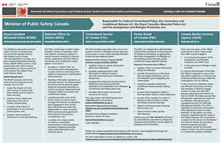
|
Overview of Federal Corrections and Criminal Justice - Victim-Centred Information and Assistance
|
Overview of Federal Corrections and Criminal Justice - Victim-Centred Information and Assistance
| 2023-05-16 |

|
Annual Report on the Use of Electronic Surveillance - 2021
|
The 2021 Annual Report covers a five-year period from 2017 to 2021. The Report includes new statistics for the period from January 1, 2021 to December 31, 2021 and updated figures for the years 2017 to 2020.
| 2023-04-04 |

|
Independent Oversight of Structured Intervention Units in Canada's Penitentiaries
|
An Update - Structured Intervention Unit Implementation Advisory Panel - 20 December 2022
| 2023-02-16 |

|
Annual National Data Report to Inform Trends and Patterns in Drug-Impaired Driving 2022
|
Produced in cooperation with provinces, territories, the RCMP and CBSA, the report presents available data on what has been done to prevent, detect and deter drug-impaired driving.
| 2023-01-27 |

|
Approaches to Addressing Serious Mental Illness in the Canadian Criminal Justice System
|
This document identifies the prevalence of mental illness in the criminal justice system, current assessment practices and approaches to treatment and programming.
| 2023-01-16 |

|
Research Summary: Approaches to Addressing Serious Mental Illness in the Canadian Criminal Justice System
|
This document is a summary that identifies the prevalence of mental illness in the criminal justice system, current assessment practices and approaches to treatment and programming.
| 2023-01-16 |
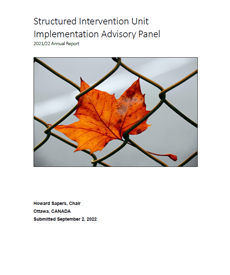
|
Structured Intervention Unit Implementation Advisory Panel 2021-22 Annual Report
|
The first Annual Report of the Structured Intervention Unit Implementation Advisory Panel concludes with recommendations to the Commissioner of the Correctional Service of Canada and advice to the Minister of Public Safety. The recommendations and advice address 14 key areas of concern regarding the operation of SIUs and the future of CSC oversight.
| 2022-10-28 |

|
Federal Framework to Reduce Recidivism
|
The Federal Framework to Reduce Recidivism is the Government of Canada's first step in putting together a plan that identifies crucial factors that impact why people reoffend and how to support safe and successful reintegration into the community.
| 2022-06-22 |

|
Sexual Coercion and Violence in Federal Corrections
|
In its 2019-2020 Annual Report, the Office of the Correctional Investigator (OCI) released a report on a national investigation into Sexual Coercion and Violence (SCV) in Canadian corrections. In this report, the OCI addressed two recommendations to the Minister of Public Safety, calling for the introduction of legislation that endorses a zero-tolerance approach to SCV and the designation of funds for a national prevalence study. The OCI also addressed recommendations to the Correctional Service of Canada (CSC) on this issue.
| 2022-05-30 |

|
Preliminary Observations of the Operation of Correctional Service of Canada's Structured Intervention Units
|
The Structured Intervention Unit (SIU) regime was established by legislation in 2019 as an attempt to respond to successful court challenges to the previous regime of “Administrative Segregation.”
| 2022-04-26 |
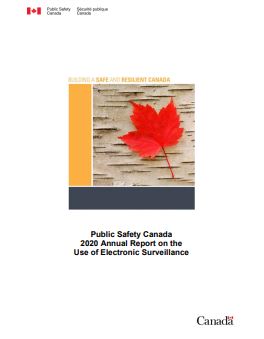
|
2020 Annual Report on the Use of Electronic Surveillance
|
The 2020 Annual Report covers a five-year period from 2016 to 2020. The Report includes new statistics for the period from January 1, 2020 to December 31, 2020 and updated figures for the years 2016 to 2019.
| 2022-02-23 |

|
2020 Corrections and Conditional Release Statistical Overview
|
This document provides a statistical overview of corrections and conditional release within a context of trends in crime and criminal justice.
| 2022-02-11 |

|
Annual National Data Report to Inform Trends and Patterns in Drug-Impaired Driving 2021
|
This is the second annual report on trends and patterns in DID. It is produced in cooperation with the provinces and territories, the RCMP, CBSA, and other partner agencies and stakeholders.
| 2022-02-09 |
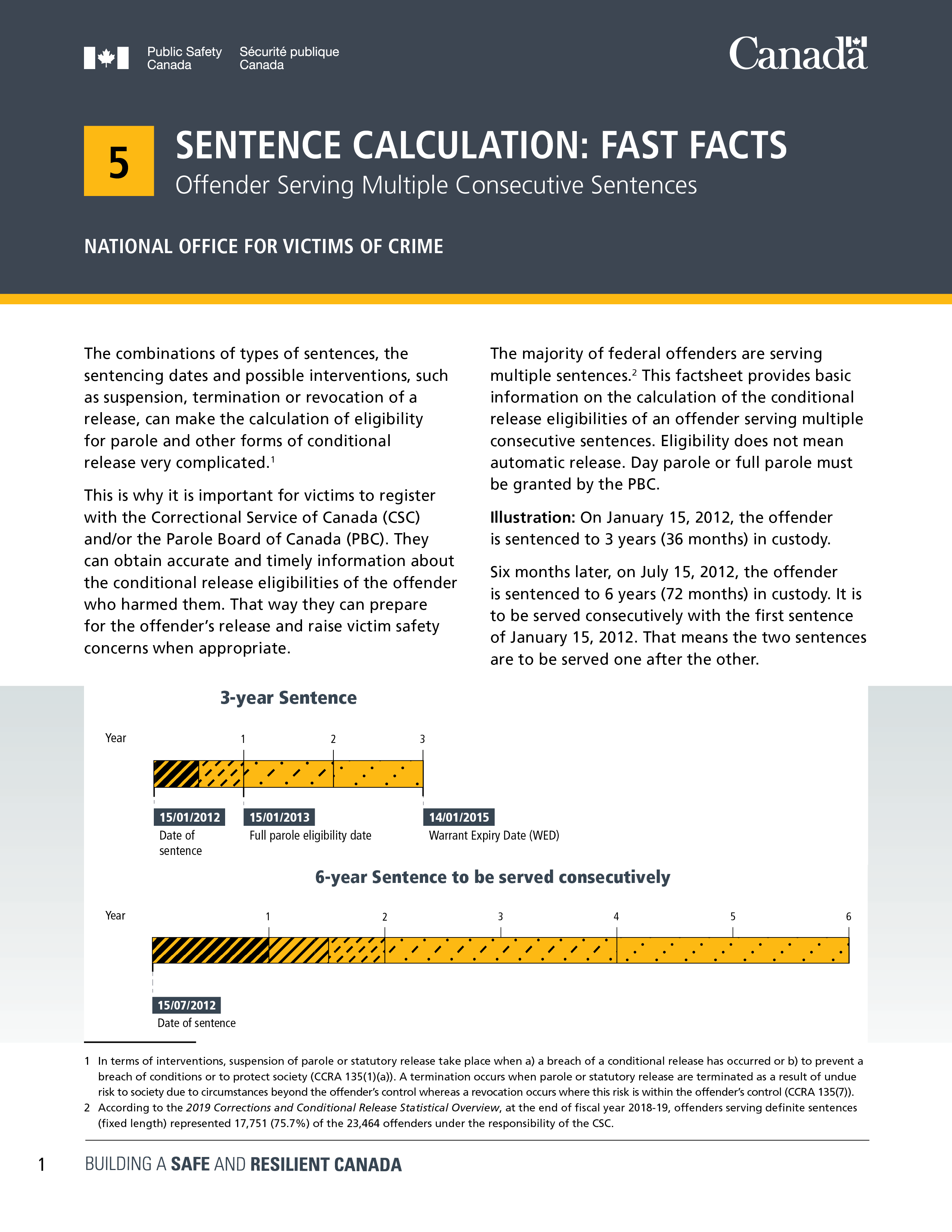
|
Sentence Calculation: Fast Facts: Offenders Serving Multiple Consecutive Sentences
|
The combinations of types of sentences, thesentencing dates and possible interventions, such as suspension, termination or revocation of arelease, can make the calculation of eligibilityfor parole and other forms of conditionalrelease very complicated.
| 2021-11-12 |
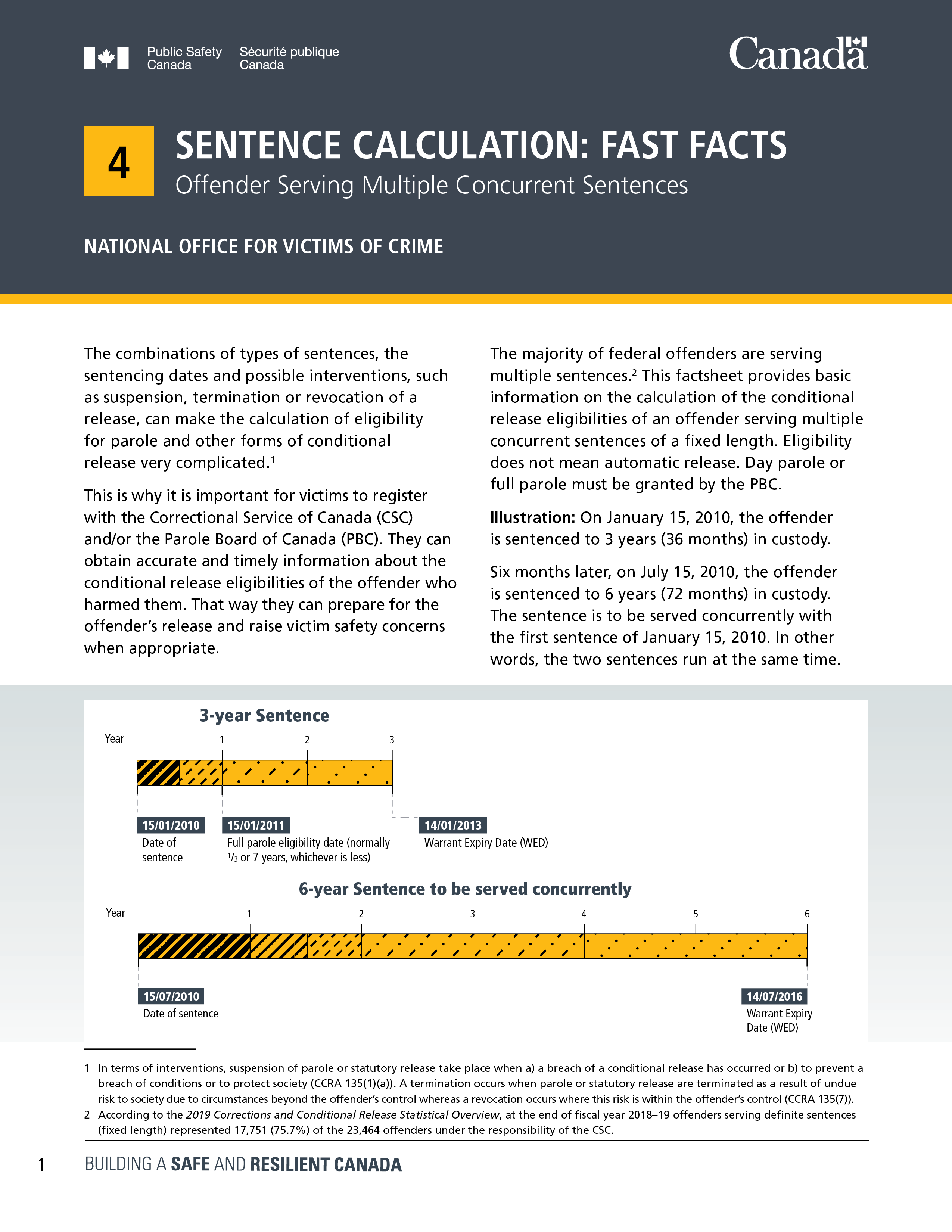
|
Sentence Calculation: Fast Facts: Offender Serving Multiple Concurrent Sentences
|
The combinations of types of sentences, thesentencing dates and possible inte rventions, such as suspension, termination or revocation of arelease, can make the calculation of eligibilityfor parole and other forms of conditionalrelease very complicated.
| 2021-11-12 |
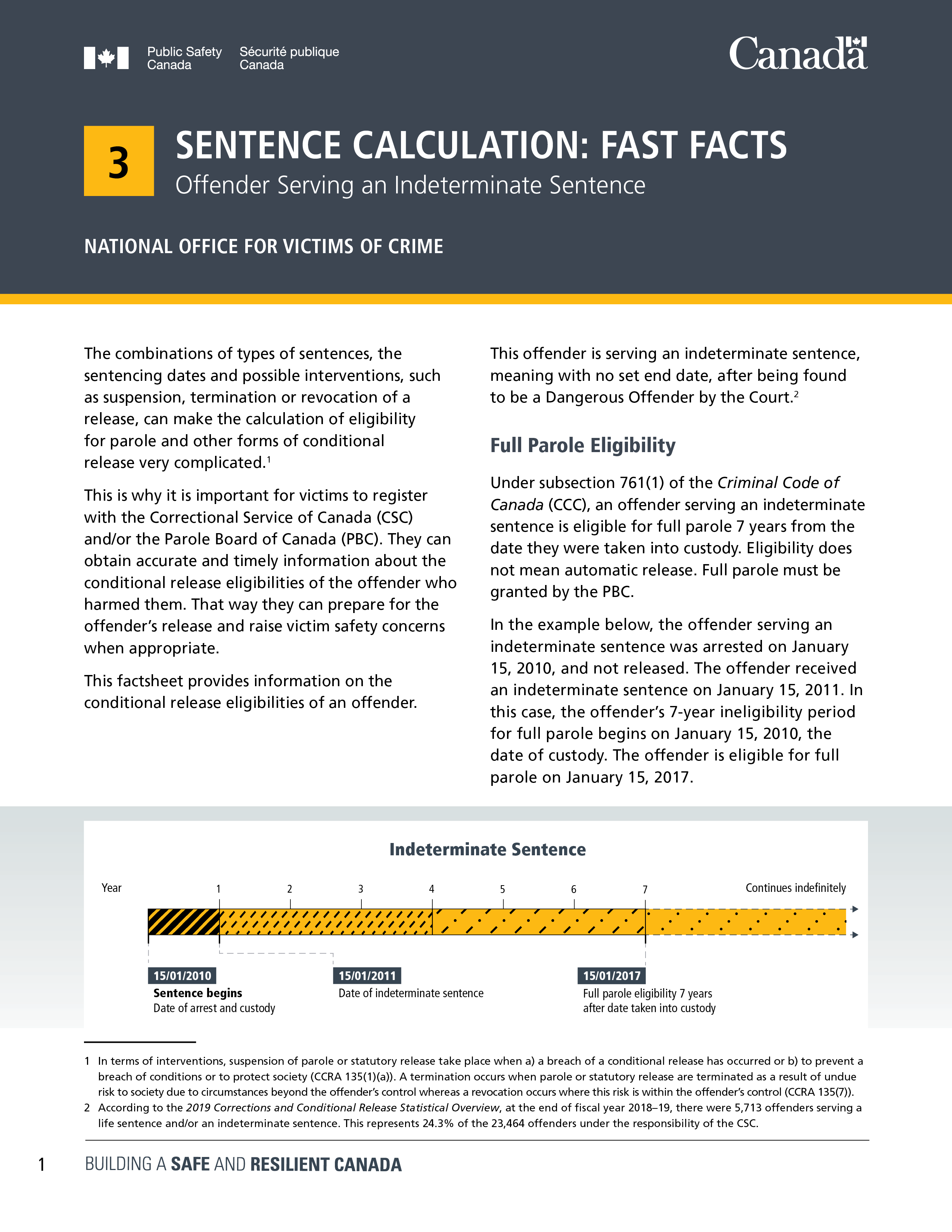
|
Sentence Calculation: Fast Facts: Offender Serving An Indeterminate Sentence
|
This factsheet provides information on theconditional release eligibilities of an offender.
| 2021-11-12 |
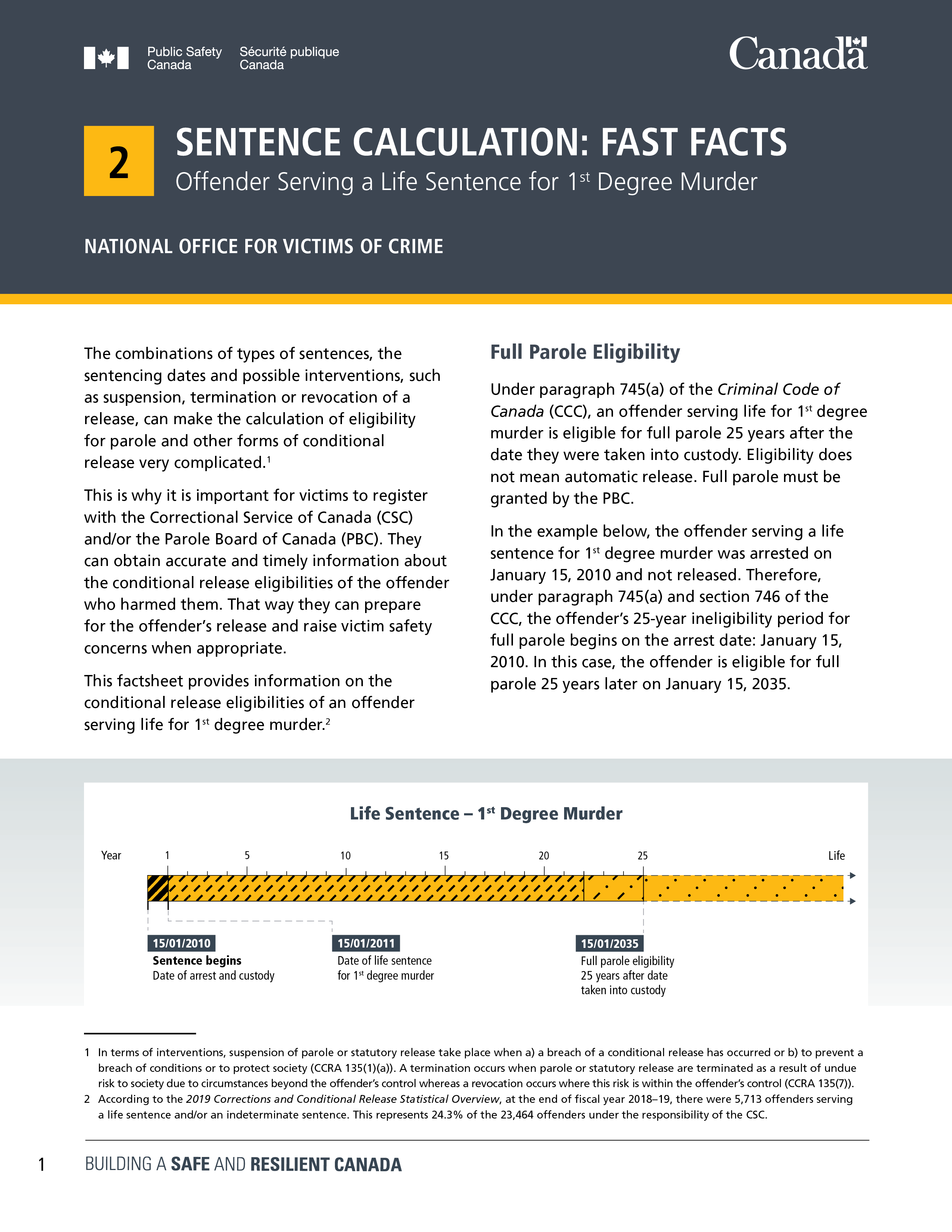
|
Sentence Calculation: Fast Facts: Offender Serving Life Sentence for 1st Degree Murder
|
This factsheet provides information on theconditional release eligibilities of an offenderserving life for 1st degree murder.
| 2021-11-12 |
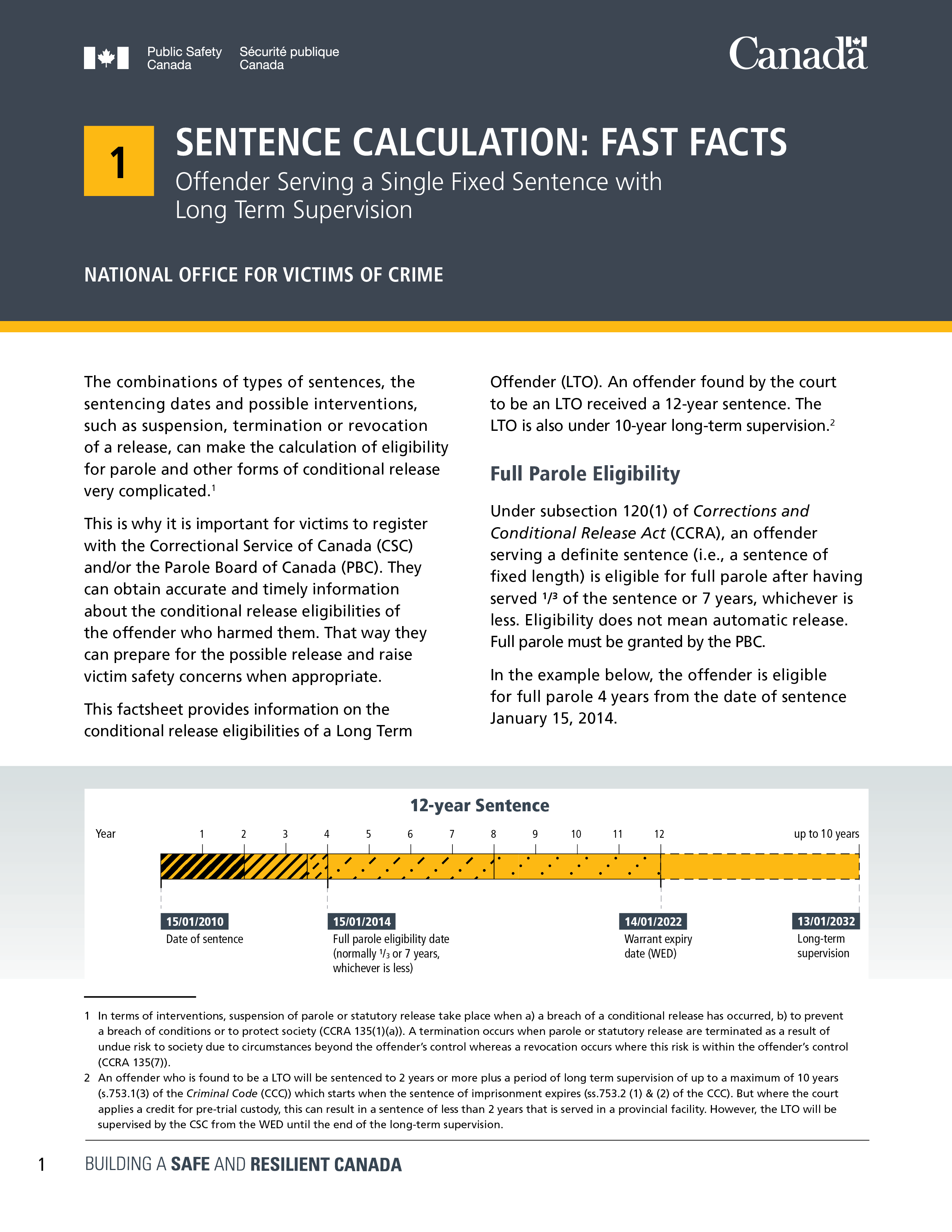
|
Sentence Calculation: Fast Facts: Offender Serving a Single Fixed Sentence with Long Term Supervision
|
This factsheet provides information on theconditional release eligibilities of a Long TermOffender (LTO). An offender found by the courtto be an LTO received a 12-year sentence. TheLTO is also under 10-year long-term supervision.
| 2021-11-12 |
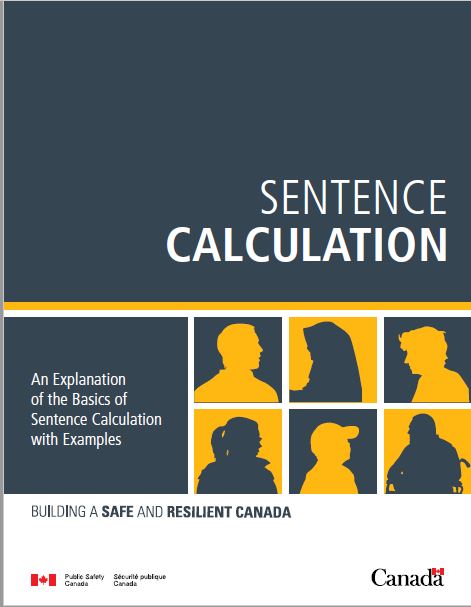
|
Sentence Calculation: An Explanation of the Basics of Sentence Calculation with Examples
|
This publication is intended to respond to requests from victims of crime, their advocates, service providers, and the general public for information about how federal sentences, meaning incarceration for over two years, are calculated.
| 2021-11-12 |

|
National Strategy to Combat Human Trafficking – Annual Report 2019-2020
|
This marks the first Annual Report on the progress of Canada's National Strategy to Combat Human Trafficking (National Strategy), which was launched on September 4, 2019. This report covers anti-human trafficking efforts from April 1, 2019 - March 31, 2020.
| 2021-07-30 |

|
2019 Annual Report on the Use of Electronic Surveillance
|
The 2019 Annual Report covers a five-year period from 2015 to 2019. The Report includes new statistics for the period from January 1, 2019 to December 31, 2019 and updated figures for the years 2015 to 2018.
| 2021-03-01 |

|
Annual National Data Report to Inform Trends and Patterns in Drug-Impaired Driving
|
In the context of cannabis legalization, the Government of Canada introduced legislation to create new offences and provide additional tools to law enforcement to detect and deter drug-impaired driving (DID).
| 2021-01-20 |

|
Increasing the Use of Restorative Justice in Criminal Matters in Canada - Baseline Report
|
This document shares the results of a survey concerning baseline data on the use of restorative justice processes in the Canadian criminal justice sector.
| 2020-11-24 |

|
2019 Corrections and Conditional Release Statistical Overview
|
This document provides a statistical overview of corrections and conditional release within a context of trends in crime and criminal justice.
| 2020-10-16 |

|
Public Safety Canada Portfolio Report: Victim Complaint Resolution Mechanism – Canadian Victims Bill of Rights
|
This report includes a brief description of victims' rights, the mandates of Public Safety Canada and its victim serving Portfolio agencies; a statistical overview of the CVBR complaints submitted in fiscal year 2018-2019, a summary of complaints received and how they were resolved, and any improvements to complaints processes.
| 2020-05-20 |

|
2018 Corrections and Conditional Release Statistical Overview
|
This document provides a statistical overview of corrections and conditional release within a context of trends in crime and criminal justice.
| 2019-08-19 |

|
2018 Human Trafficking Consultations Report
|
This report breaks down the findings of the consultations by key themes identified in participants' responses.
| 2019-08-16 |

|
Public Safety Canada Portfolio Report: Victim Complaint Resolution Mechanisms -
Canadian Victims Bill of Rights
|
This is the second
Public Safety Portfolio Report: Victim Complaint Resolution Mechanisms
since the coming into force of the CVBR. The report includes a brief description of victims' rights, the mandates of Public Safety Canada and its victim serving Portfolio agencies; a statistical overview of CVBR complaints submitted in fiscal year 2017-2018, a summary of complaints received and how they were resolved, and any improvements to complaints processes.
| 2019-06-21 |

|
Engagement Summary Report - Reducing Violent Crime: A Dialogue on Handguns and Assault-Style Firearms
|
Public Safety Canada (“Public Safety”) launched an engagement process in October 2018 to help inform policy, regulations and legislation to reduce violent crime involving firearms.
| 2019-04-11 |
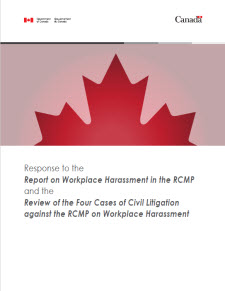
|
Response to Report on Workplace Harassment in the RCMP and the Review of Four Cases of Civil Litigation against the RCMP on Workplace Harassment
|
There can be no more important obligation for a Government than the protection and safety of its citizens. For 145 years, the Royal Canadian Mounted Police has played an indispensable role in this regard.
| 2019-01-16 |

|
The Canada Centre for Community Engagement and Prevention of Violence - What we heard
|
This report is based on the valuable feedback, ideas, opinions, and perspectives as submitted by contributors to the online public consultation. The information presented is directional in nature and as participation was on an open opt-in basis, the results should not be extrapolated to a broader audience.
| 2018-09-24 |

|
2017-2018 Evaluation of the National Crime Prevention Strategy
|
This report presents the results of the 2017-18 Evaluation of the National Crime Prevention Strategy (NCPS). The NCPS is the framework for crime prevention initiatives in Canada.
| 2018-09-20 |

|
Summary of the 2017-18 Evaluation of the National Crime Prevention Strategy
|
This report presents the results of the 2017-18 Evaluation of the National Crime Prevention Strategy (NCPS). The NCPS is the framework for crime prevention initiatives in Canada.
| 2018-09-20 |
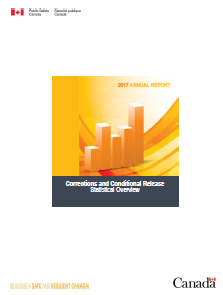
|
2017 Corrections and Conditional Release Statistical Overview
|
This document provides a statistical overview of corrections and conditional release within a context of trends in crime and criminal justice.
| 2018-09-10 |

|
Summit on Gun and Gang Violence: Summary Report
|
Firearm-related homicides in Canada have been steadily increasing, reaching a total of 223 in 2016, 44 more than the previous year. Shootings have now become the most common method of homicide, surpassing homicide by stabbing and beating.
| 2018-06-19 |
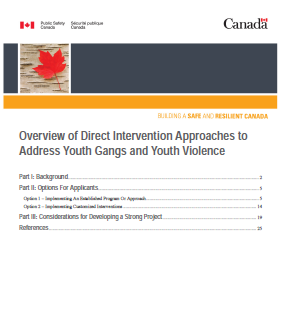
|
Overview of Direct Intervention Approaches to Address Youth Gangs and Youth Violence
|
Gang-involved youth are considered to be some of the main perpetrators (and victims) of crime and violence, and impose a high burden on society in terms of criminal justice system and other societal costs.
| 2018-06-11 |
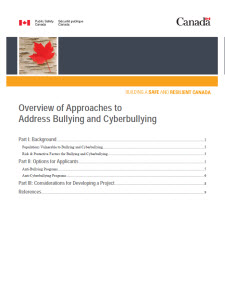
|
Overview of Approaches to Address Bullying and Cyberbullying
|
Bullying and cyberbullying are recognized globally as complex and serious problems that have significant negative health and social impacts. Prevention and intervention approaches that seek to address these problems can have an impact on the short- and long-term effects of bullying/cyberbullying others and/or experiencing victimization.
| 2018-06-11 |

|
Helping Victims Prepare for the Release of a Federal Offender
|
This booklet provides steps you can take to protect yourself and your loved ones, and to help you feel safe and supported, when the offender who harmed you is being reintegrated into society.
| 2018-04-27 |

|
Public Safety Canada Portfolio Report: Canadian Victims Bill of Rights - Victim Complaint Resolution Mechanisms
|
This report provides a brief explanation of the Canadian Victims Bill of Rights and details victim complaint resolution mechanisms across the Public Safety Portfolio. It includes improvements made, statistics, findings and future policy/process considerations.
| 2018-04-23 |

|
Research Highlights - Crime Prevention : Transitions From Juvenile Delinquency to Young Adult Offending: A Review of Canadian and International Evidence
|
This document reviews longitudinal research on key questions concerning transitions from juvenile delinquency to young adult offending.
| 2018-02-23 |

|
Research Summary - Transitions From Juvenile Delinquency to Young Adult Offending: A Review of Canadian and International Evidence
|
This review examines Canadian and international longitudinal studies concerning the transition from juvenile delinquency to young adult offending.
| 2018-02-23 |
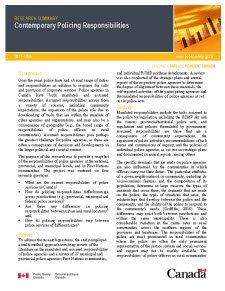
|
Research Summary - Contemporary Policing Responsibilities
|
The purpose of this research was to provide a snapshot of the responsibilities of police agencies at the national, provincial, and municipal levels, and in First Nations communities.
| 2018-02-23 |
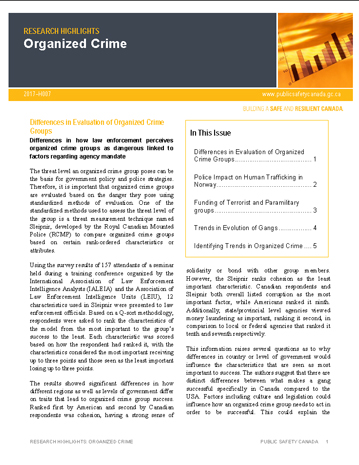
|
Organized Crime – Research Highlights 2017-H007
|
The study highlights the differences in evaluation of Organized Crime Groups; Police Impact on Human Trafficking in Norway; Funding of Terrorist and Paramilitary groups; Trends in Evolution of Gangs; Identifying Trends in Organized Crime.
| 2018-02-23 |

|
Research Summary - Research Symposium on Cannabis
|
On September 27, 2017, Public Safety Canada hosted a Research Symposium on Cannabis in Ottawa, Ontario. The event brought together researchers from various federal departments, provincial and territorial governments, universities and non-governmental organizations to discuss the current state of cannabis-related research and to identify gaps and future research priorities.
| 2018-01-12 |

|
Static-99R Coding Rules Revised – 2016
|
This manual comprises the third published version of the coding rules for Static-99R; a risk assessment tool designed to predict reoffending among individuals with sexual offences.
| 2017-12-19 |

|
Organized Crime – Research Highlights 2017-H006
|
The Territorial Expansion of Mafia Style Organized Crime; Intervening in the Recruitment Pathway as a Response to Organized Crime; Policy Effects in Transnational Illicit Markets; Monitoring Online Offenders; A Typology for ‘Polymorphous Criminal Networks' and Diversification or Co-occurrence.
| 2017-10-12 |
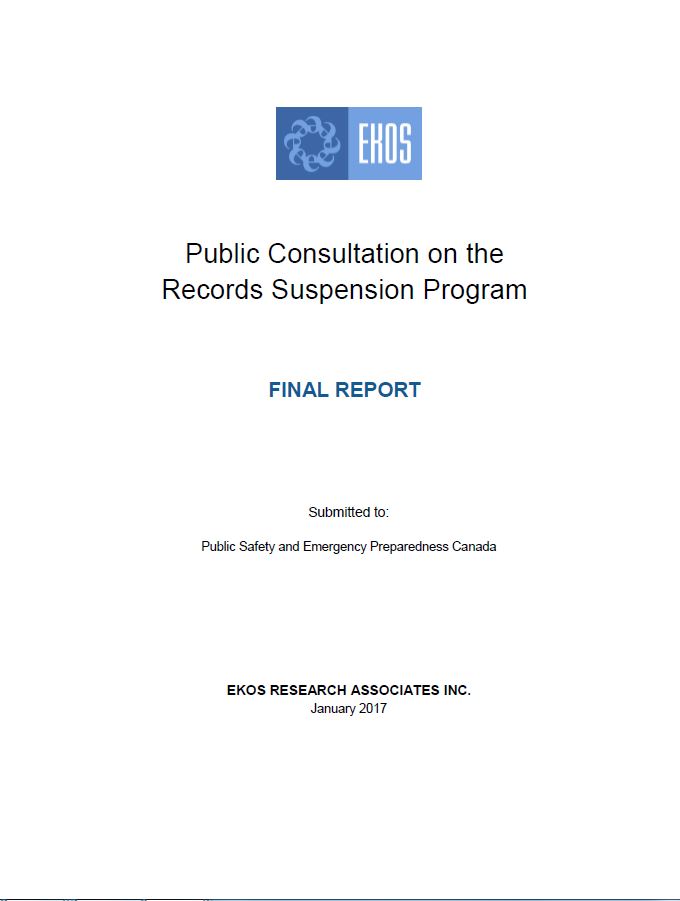
|
Public Consultation on the Records Suspension Program
|
Between November 7 and December 16, 2016, PS conducted an online public consultation regarding a review of legislative reforms made during the last 10 years concerning the Record Suspension Program, as outlined in the CRA.
| 2017-10-10 |

|
What we Heard - Public Consultations on the Record Suspension Program - Final Report
|
The Government of Canada has committed to conduct a review of the legislative changes made to the criminal justice system over the past decade. In support of this commitment, a public online consultation regarding the record suspension (formerly referred to as pardons) program, as outlined in the Criminal Records Act (CRA), was held between November 7 and December 16, 2016, with a total of 1,166 submitted surveys.
| 2017-10-10 |

|
Parole Board of Canada User Fees Consultation – What We Heard Summary Report
|
The Parole Board of Canada (PBC) conducted an online consultation with key stakeholders (i.e., general public, criminal justice system partners, individuals who have a criminal record, record suspension companies, offender advocacy groups, and Indigenous groups) to get their input on its record suspension user fee.
| 2017-10-10 |

|
Parole Board of Canada User Fees – Online Consultation Detailed Report
|
This report provides an overview of the comments, ideas, and suggestions received on the record suspension program.
| 2017-10-10 |

|
2016 Corrections and Conditional Release Statistical Overview
|
This document provides a statistical overview of corrections and conditional release within a context of trends in crime and criminal justice.
| 2017-09-15 |

|
Organized Crime - Research Highlights 2016-H005
|
Gang Membership Patterns in the Life-Course; Organized Cybercrime and Social Opportunity Structures; Best Practices in Policing Transnational Organized Crime; Lawyers and Organized Crime; Attrition in the Investigation and Confiscation of Profits of Organized Crime.
| 2017-08-02 |

|
National Action Plan to Combat Human Trafficking - 2015-16 Annual Report on Progress
|
This is the fourth Annual Report on Progress on the implementation of Canada's National Action Plan to Combat Human Trafficking (National Action Plan), which was launched on June 6, 2012.
| 2017-06-12 |

|
Organized Crime - Research Highlights 2016-H003
|
Evaluation of the Impact of the Ceasefire Operation in Boston; Examination of Drug Supply Seizures and Related Harm in Australia; Moral Disengagement and Youth Gangs in the UK; The Impact of Leadership Removal on Mexican Drug Trafficking Organizations; Honesty of Gang Members When Asked if They are in a Gang; Debunking the Taxation-Contraband Tobacco Myth
| 2017-03-15 |

|
Collaborative Risk-Driven Intervention – A Study of Samson Cree Nation's Application of the Hub Model
|
In an effort to reduce crime and violence in their community, police and local leaders at Samson Cree Nation in central Alberta have implemented the Hub model of collaborative risk-driven intervention since 2012.
| 2016-12-02 |

|
Research Summary: Cannabis Policy Performance Metrics
|
The objective of this project is to itemize and discuss the main performance metrics suggested for the assessment of cannabis policy regimes. The intent is to discuss the various performance metrics that currently exist, as well as others that may need to be considered in advance, and upon implementation of, a new cannabis policy regime in Canada.
| 2016-09-27 |

|
Cannabis Performance Metrics for Policy Consideration – What Do We Need to Measure?
|
The objective of this project is to itemize and discuss the main performance metrics suggested for the assessment of cannabis policy regimes. The intent is to discuss the various performance metrics that currently exist, as well as others that may need to be considered in advance, and upon implementation of, a new cannabis policy regime in Canada.
| 2016-09-27 |

|
Ways to Consider Non-Medical Cannabis - Reasoning from Conceptual Analogues
|
The objective of this report was to identify the similarities and differences between psychoactive cannabis and analogous legal substances consumed for their psychoactive properties, and describe the characteristics applied when discussing or fashioning regimes related to the control of these substances in order to identify approaches and considerations for consultation and policy discussion.
| 2016-09-27 |
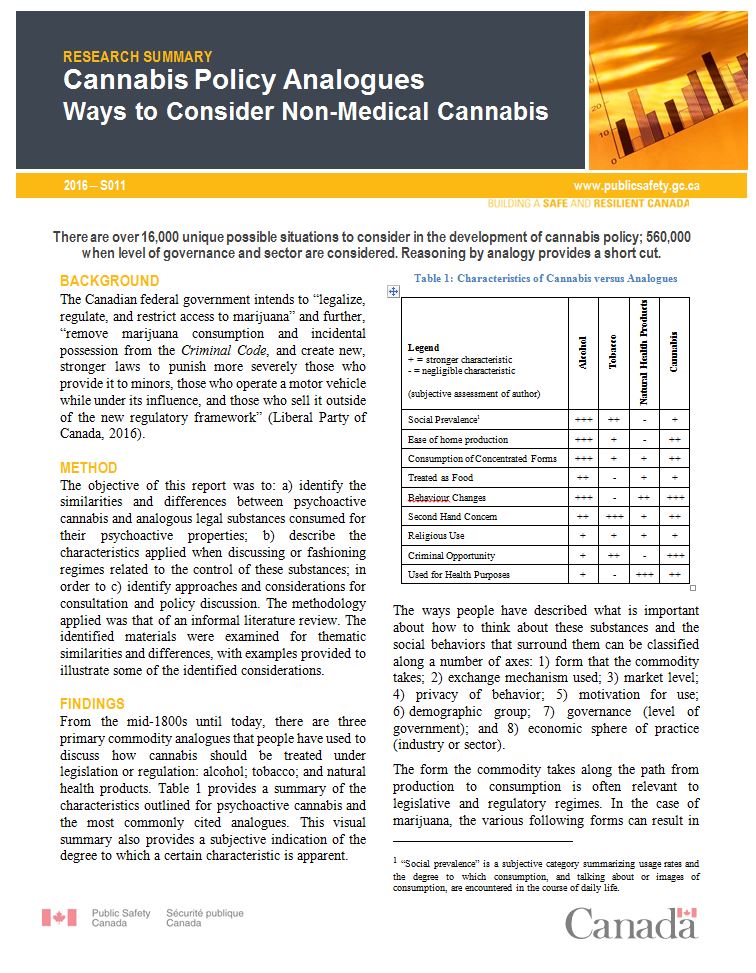
|
Research Summary: Cannabis Policy Analogues - Ways to Consider Non-Medical Cannabis
|
The objective of this report was to identify the similarities and differences between psychoactive cannabis and analogous legal substances consumed for their psychoactive properties, and describe the characteristics applied when discussing or fashioning regimes related to the control of these substances in order to identify approaches and considerations for consultation and policy discussion.
| 2016-09-27 |

|
Police Performance Metrics - Research Brief no. 31
|
Some key police performance metrics must be gathered through public opinion surveys. Little reliable information of this type is currently collected. Improving the validity and frequency of collected data would enhance police performance measurement.
| 2016-08-26 |

|
Workshop on Human Trafficking Summary Report
|
Public Safety Canada (PS) would like to thank the individuals and organizations for their participation in the two-day Workshop on Human Trafficking and their dedication to the fight against this illegal activity, both in Canada and abroad.
| 2016-06-24 |
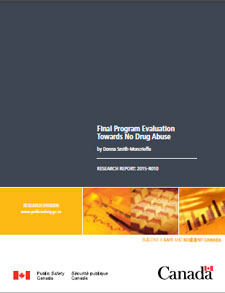
|
Final Program Evaluation – Towards No Drug Abuse
|
Towards No Drug Abuse (TND) is an evidence-based program designed to help youth reduce their tobacco, alcohol or drug use, and violent behaviour.
| 2016-06-24 |
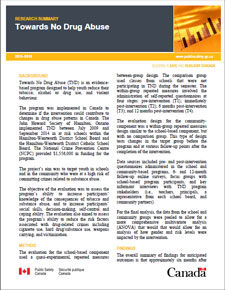
|
Research Summary: Towards No Drug Abuse
|
Towards No Drug Abuse (TND) is an evidence-based program designed to help youth reduce their tobacco, alcohol or drug use, and violent behaviour.
| 2016-06-24 |

|
Fundamentals of Cyber Security for Canada's CI Community
|
This document offers action-oriented guidance and mitigation measures to raise awareness and begin working towards achieving a minimum baseline level of cyber security; however, it is not a definitive guide on all aspects of cyber security.
| 2016-06-24 |

|
What Constitutes a Cognitive-Behavioural Intervention with Offenders?
|
There has been much discussion by corrections professionals concerning what actually constitutes a cognitive-behavioural intervention. As a result, this Research Summary clarifies the essential elements of cognitive-behavioural intervention with offenders.
| 2016-06-20 |
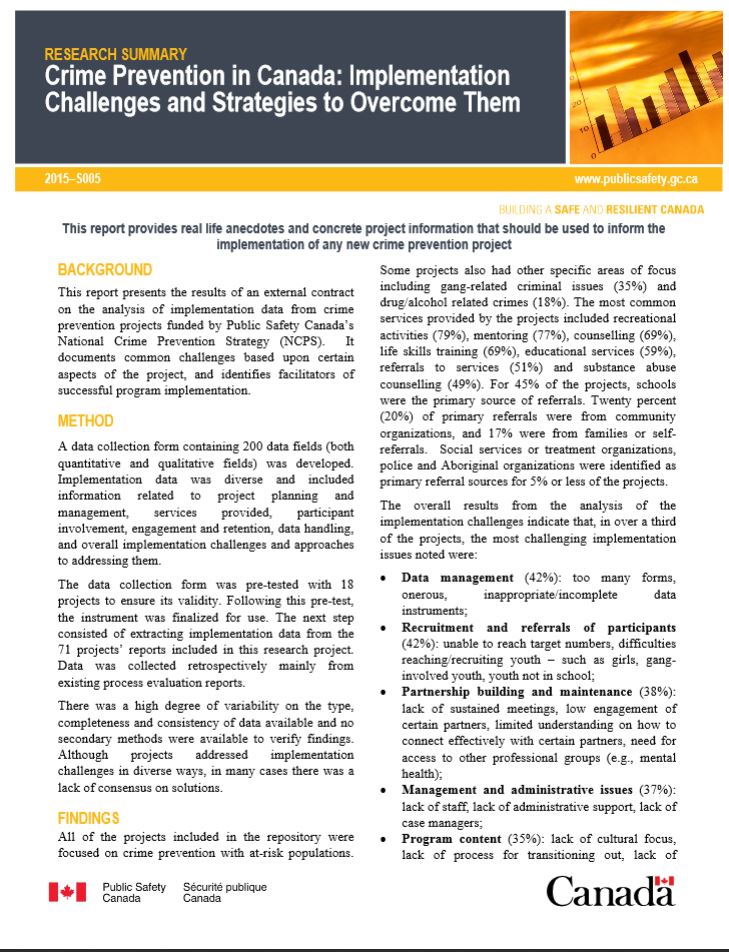
|
Research Summary: Crime Prevention in Canada: Implementation Challenges and Strategies to Overcome Them
|
This report presents the results of an external contract on the analysis of implementation data from crime prevention projects funded by Public Safety Canada's National Crime Prevention Strategy (NCPS).
| 2016-04-21 |
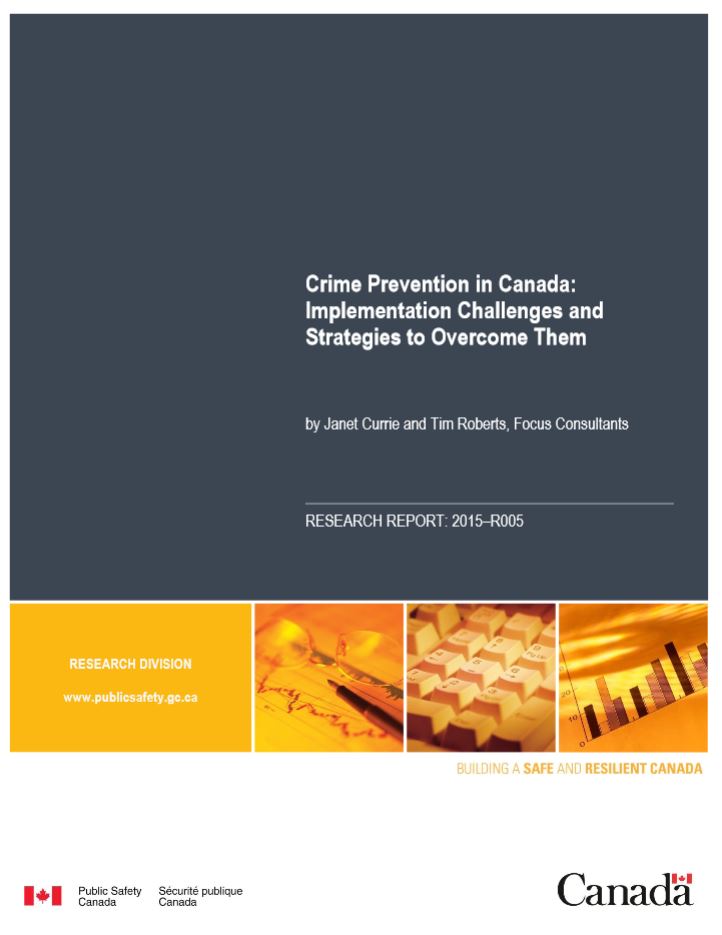
|
Crime Prevention in Canada: Implementation Challenges and Strategies to Overcome Them
|
This report presents the results of an analysis of implementation data from seventy-one crime prevention projects funded by Public Safety Canada's National Crime Prevention Strategy (NCPS).
| 2016-04-21 |

|
2015 Corrections and Conditional Release Statistical Overview
|
This document provides a statistical overview of corrections and conditional release within a context of trends in crime and criminal justice.
| 2016-04-21 |

|
Amalgamation of Police Services
|
Police amalgamation (also referred to as regionalization, consolidation, or merger) has been a focus for administrators of police service delivery since the early 1950s.
| 2016-04-21 |

|
Amalgamation of Police Services Research Summary
|
The amalgamation of small police services into larger medium-sized regional entities may have efficiency advantages, but there are limited or no cost savings in amalgamating medium to larger police services.
| 2016-04-21 |

|
National Action Plan to Combat Human Trafficking - 2014-15 Annual Report on Progress
|
Third Annual Report on Progress on the implementation of Canada's National Action Plan to Combat Human Trafficking (National Action Plan), which was launched on June 6, 2012.
| 2016-03-24 |

|
Canada's Anti-Human Trafficking Newsletter - Issue 8
|
This newsletter is being offered up to four times yearly by the Serious and Organized Crime Division at Public Safety Canada with content provided by anti-trafficking stakeholders from across Canada.
| 2016-03-11 |

|
Research Summary: Velocity Adventure Program
|
Velocity Adventure Program (Velocity) is a promising intervention that helps youth overcome adversity, create and enhance their connections in the community, and make healthy lifestyle choices.
| 2016-01-15 |
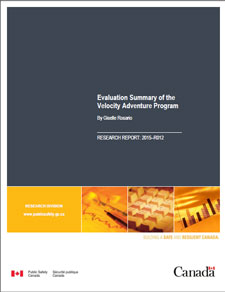
|
Evaluation Summary of the Velocity Adventure Program
|
Public Safety Canada's National Crime Prevention Strategy (NCPS) has a mandate to develop and disseminate knowledge of effective crime prevention programs to help decision makers and practitioners in communities across the country to make the best use of their crime prevention resources.
| 2016-01-08 |

|
Economics of Policing and Community Safety - Policy Makers' Dialogue on Privacy and Information Sharing - Workshop Report
|
In October 2014, Federal, Provincial and Territorial Ministers Responsible for Justice and Public Safety approved the Economics of Policing and Community Safety Shared Forward Agenda, a strategy for the future of policing in Canada.
| 2016-01-08 |

|
Evaluation Summary Community Cadets Corps (CCC) Program
|
The Community Cadets Corps (CCC) program evaluation was undertaken to examine the effectiveness of Cadets as a crime prevention measure for Aboriginal youth.
| 2015-11-27 |

|
Organized Crime - Research Highlights 2015-H002
|
Restricting access to chemicals used to produce synthetic drugs restricted supply and caused displacement of methods and sources of production.
| 2015-11-27 |

|
Organized Crime - Research Highlights 2015-H001
|
In Canada, between CAD 5 billion and 15 billion is estimated to be laundered annually; worldwide the figure is between USD 500 billion and 1 trillion.
| 2015-11-27 |

|
Info Sheet: Cyberbullying
|
Cyberbullying has been defined as 'willful and repeated harm inflicted through the use of computers, cell phones, and other electronic devices'
| 2015-11-27 |

|
Research Summary: Community Cadets Corps Program
|
The Community Cadets Corps (CCC) program evaluation was undertaken to examine the effectiveness of Cadets as a crime prevention measure for Aboriginal youth.
| 2015-11-27 |

|
Research Summary: Multisystemic Therapy Program Evaluation
|
Multisystemic Therapy (MST) is a widely-used, evidence-based prevention program aimed at reducing anti-social behaviour and recidivism among at-risk youth.
| 2015-11-27 |

|
Final Evaluation Summary of the Multisystemic Therapy Program
|
Multisystemic Therapy (MST) is a widely-used, evidence-based prevention program aimed at reducing anti-social behaviour and recidivism among at-risk youth.
| 2015-11-27 |

|
2014 Corrections and Conditional Release Statistical Overview
|
This document provides a statistical overview of corrections and conditional release within a context of trends in crime and criminal justice.
| 2015-11-13 |

|
2013-2014 Evaluation of the National Strategy for the Protection of Children from Sexual Exploitation on the Internet
|
The evaluation covered the activities delivered under the National Strategy by Public Safety Canada, including: the Canadian Centre for Child Protection as a funding recipient for the management of the national tipline Cybertip.ca, the Royal Canadian Mounted Police (through NCECC—National Child Exploitation Coordination Centre, a national division of the Canadian Police Centre for Missing and Exploited Children/Behavioural Sciences Branch) and the Department of Justice.
| 2015-11-13 |

|
Research Summary: A Literature Review on the Amalgamation of Police Services in Canada
|
There is a trend towards amalgamating police services. Medium-sized police services appear to be particularly effective.
| 2015-05-15 |
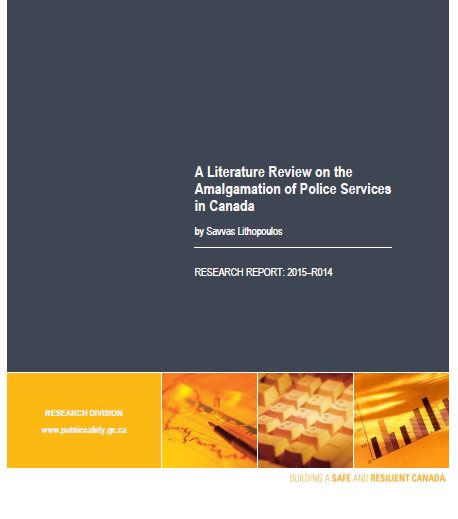
|
A Literature Review on the Amalgamation of Police Services in Canada
|
Despite claims and popular assumptions surrounding police regionalization, the studies reviewed demonstrated that large regional police services are not particularly more effective or efficient than medium-sized non-regional services.
| 2015-05-15 |

|
National Action Plan to Combat Human Trafficking - 2013-2014 Annual Report on Progress
|
Second Annual Report on Progress on the implementation of Canada's National Action Plan to Combat Human Trafficking (National Action Plan), which was launched on June 6, 2012.
| 2015-05-08 |

|
National Forum on Human Trafficking - Summary Report, 2014
|
National Forum on Human Trafficking - Summary Report, 2014
| 2015-05-08 |

|
Building the Evidence – Crime Prevention in Action - The X-Roads Crime Prevention Program (X-Roads)
|
The X-Roads Crime Prevention Project (X-Roads) provided prevention and intervention activities for Aboriginal children and youth aged 6–18 years and at risk of becoming involved in gang activity in The Pas, Manitoba.
| 2015-02-06 |

|
Leadership and Resiliency Program (LRP) - Crime Prevention in Action
|
Public Safety Canada has a mandate to develop and disseminate knowledge of effective crime prevention programs to help decision makers and practitioners across the country make the best use of their crime prevention resources.
| 2015-02-06 |
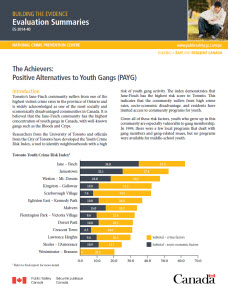
|
The Achievers: Positive Alternatives to Youth Gangs (PAYG)
|
Toronto's Jane-Finch community suffers from one of the highest violent crime rates in the province of Ontario and is widely acknowledged as one of the most socially and economically disadvantaged communities in Canada.
| 2015-01-30 |

|
PréCrimAdo Program
|
In recent years, three youth centres (Québec, Chaudière–Appalaches and Montérégie) and a team of researchers from Laval University collaborated to examine the results of the PréCrimAdo Program (preventing the criminalization of high-risk adolescents).
| 2015-01-30 |
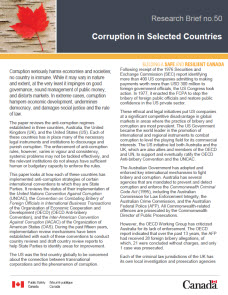
|
Corruption in Selected Countries - Research Brief no. 50
|
Corruption seriously harms economies and societies; no country is immune. While it may vary in nature and extent, at the very least it impinges on good governance, sound management of public money, and distorts markets. In extreme cases, corruption hampers economic development, undermines democracy, and damages social justice and the rule of law.
| 2014-11-21 |
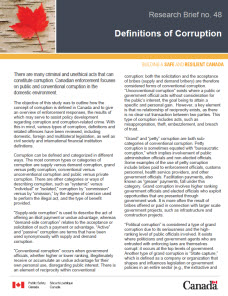
|
Definitions of Corruption - Research Brief no. 48
|
There are many criminal and unethical acts that can constitute corruption. Canadian enforcement focuses on public and conventional corruption in the domestic environment.
| 2014-11-21 |

|
Building the Evidence – Project Summaries – LINK –LINKing Refugee Youth and Families to Positive Social Supports
|
LINKing Refugee Youth and Families to Positive Social Supports (LINK) is an innovative program designed to prevent the involvement of refugee youth in criminal and gang-related activity.
| 2014-11-21 |

|
2014 National Policing Research Symposium: Outcomes Report
|
Canadian police services are facing a range of challenges and opportunities. The cost of policing ($13.5 billion in 2013) continues to rise yearly despite a steady drop in reported crime.
| 2014-09-26 |

|
Building the Evidence – Crime Prevention in Action – Walking the Path Together
|
This Crime Prevention in Action provides information on the implementation of the Walking the Path Together Program. It is a culturally based, innovative, five-year program that works with young Aboriginal children aged 6 to 11 and their families to address chronic family violence, the foundation of intergenerational violence, and future offending behaviours. The project is being implemented from July 2009 to March 2014 in the Alberta communities of Wabasca, Morley, Hobbema, Fort Chipewyan and Enilda.
| 2014-09-26 |

|
Building the Evidence – Project Summaries – Strengthening the Spirit
|
This Summary presents what was learned from the implementation of 'Strengthening the Spirit', a prevention program for Aboriginal families at high risk of violent behaviour and contact with the criminal justice system. It was funded by the National Crime Prevention Centre (NCPC) from February, 2009 to September, 2012. It was designed to reduce domestic violence in families, reduce the risk of violence for children, and support families' healing and wellness. The participants came from three First Nations communities near Calgary, Alberta and four Calgary-based organizations serving mainly Aboriginal people.
| 2014-09-26 |

|
Building the Evidence - Project Summaries - Spirit: Girls Identifying Real Life Solutions
|
This summary presents what was learned from the implementation of Spirit, a school-based prevention program for girls from grades 7 to 9 at risk of delinquency and contact with the criminal justice system. It was implemented as a pilot project from September 2008 to August, 2011 in Calgary, Alberta.
| 2014-09-26 |

|
Crime Prevention in Action – LifeSkills Training (LST) Program
|
This Crime Prevention in Action provides information on the implementation of the LifeSkills® Training (LST) Program and the LST projects that the NCPC has supported in locations across Canada. LST is a school-based prevention program that targets early drug and alcohol use by adolescents, especially those in junior high school (grades 6 and 7). The main goals of the LST Program are to prevent substance use amongst adolescents and to promote healthy alternatives to risky behaviour.
| 2014-09-26 |

|
Canada's Anti-Human Trafficking Newsletter - Issue 6, July 2014
|
This newsletter is being offered up to three times yearly by the Serious and Organized Crime Division at Public Safety Canada with content provided by anti-trafficking stakeholders from across Canada.
| 2014-07-31 |

|
Economics of Policing: Baseline for Policing Research in Canada
|
The increasing complexity of the issues surrounding the delivery of police services requires that policy-makers, operational personnel and funding bodies be informed by evidence-based research. This is optimized when there is: funding for police research; police services have the capacity to conduct analyses on all phases of their operations; there are collaborative relationships between the police and academia; and structures exist to facilitate the dissemination of research findings to a wide audience.
| 2014-07-17 |

|
Organized Crime Research Highlights Number 7
|
Alliances and Conflicts in Street Gangs; Solving Gang Homicides; Counting Drug Users; Regulating Illicit Markets; Economic Cost of Organized Crime; Reducing Offending Opportunities
| 2014-06-24 |

|
Witness Protection Programs in Selected Countries - Research Brief no. 43
|
Effective witness protection is a cornerstone of the criminal justice system in the fight against organized crime. Traditional witness protection focuses on the safety of the witness. Experience shows, however, that individuals are not willing unless they have confidence that the State will protect their rights and safety as well as those of their immediate family.
| 2014-06-17 |

|
Organized Crime Research Highlights Number 6
|
Deterrence and Criminal Lifestyles; Drug Market Money-launders; Evaluation of U.S. Anti-Gang Initiatives; Co-offending Patterns and Organized Crime; Production of Synthetic Drugs in Quebec
| 2014-05-28 |

|
Canada's Anti-Human Trafficking Newsletter - Issue 5, February 2014
|
Canada's Anti-Human Trafficking Newsletter - Issue 5, February 2014
| 2014-02-28 |

|
Economics of Policing: Summary Report of the Police Education and Learning Summit
|
On September 17 and 18, 2013, the
Economics of Policing: Police Education and Learning Summit
brought together, in Charlottetown, Prince Edward Island, more than one hundred representatives from approximately thirty Canadian police services, the three national police associations, federal and provincial representatives, as well as academic organizations to examine efficiencies in police training. Co-hosted by Public Safety Canada and the Canadian Police Knowledge Network (CPKN), this event was structured around the broader 'economics of policing' dialogue while specifically focussing on issues related to police training.
| 2014-01-17 |

|
Trends in Indigenous Policing Models: An International Comparison
|
The report reviews Indigenous policing models in Canada, the United States, Australia and New Zealand
| 2013-12-20 |

|
Canadian Police Board Views on the Use of Police Performance Metrics
|
Cost-of-service trends are a major concern for the Canadian policing community and the public sector in general. In calendar year 2011 alone, total operating expenditures for Canadian local policing was roughly $12.9 billion. In response, innovative Canadian police services have begun to adopt a new management paradigm focusing on the use of performance indicators to help to: 1) rethink what services are of highest priority; 2) generate improved outcomes; and 3) better control service delivery costs.
| 2013-11-18 |
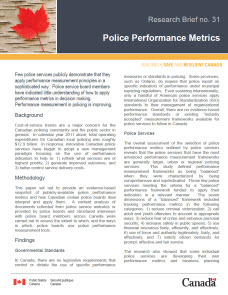
|
Police Performance Metrics - Research Brief no. 31
|
Few police services publicly demonstrate that they apply performance measurement principles in a sophisticated way. Police service board members have indicated little understanding of how to apply performance metrics in decision making. Performance measurement in policing is improving.
| 2013-11-18 |

|
Crime Prevention in Action - Stop Now And Plan (SNAP)
|
This Crime Prevention in Action summary provides information on Stop Now and Plan (SNAP) and the SNAP projects Public Safety is supporting in various locations across Canada. It addresses issues to be considered by those interested in implementing a SNAP program.
| 2013-11-08 |

|
Youth Gang Prevention Fund Projects : What Did We Learn About What Works in Preventing Gang Involvement?
|
This Research Report provides a synthesis of key findings from the impact evaluations of 14 youth gang prevention projects implemented in various locations across Canada between 2007 and 2012. It provides a context for Public Safety's NCPC work on youth gangs, briefly describes the funded projects and the approach to conducting the evaluation studies, presents the key findings, and provides some conclusions for moving forward.
| 2013-11-08 |

|
Results from the Stop Now And Plan (SNAP) Program
|
This Evaluation Summary provides preliminary findings from the SNAP program being implemented and evaluated in Toronto, Edmonton and a Cree Nation community in Quebec. SNAP is a community-based program for children under the age of twelve who have come into contact, or are at risk of coming into contact, with the criminal justice system, and who display early signs of anti-social or aggressive behaviour.
| 2013-11-08 |
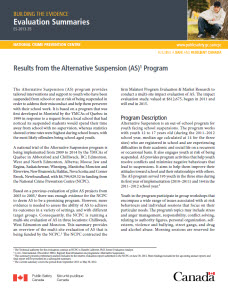
|
Results from the Alternative Suspension (AS) Program
|
This Evaluation Summary provides preliminary findings from the Alternative Suspension (AS) Program being implemented and evaluated in three locations – Chillwack, BC; West Edmonton, AB; and Moncton, NB. The Alternative Suspension (AS) program is designed for youth suspended from school, or at risk of being suspended, and addresses their misconduct while helping them persevere with their school work.
| 2013-11-08 |

|
2012-2013 Evaluation of the Crime Prevention Program
|
Evaluation supports accountability to Parliament and Canadians by helping the Government of Canada to credibly report on the results achieved with resources invested in programs.
| 2013-11-08 |

|
Organized Crime Research Highlights Number 5
|
Anonymous Online Marketplace for Illicit Goods; Victim-Offender Mediation and Organized Crime; Locating the Source of Diffusion in Large-Scale Networks; Drug Market Disruption and Violence; Quebec's Synthetic Drug Market
| 2013-10-29 |

|
Canada's Anti-Human Trafficking Newsletter Special Edition
|
Public-Private Partnerships (PPPs) are joint ventures between the public sector (i.e., different levels of government) and the private sector (i.e., businesses, charitable foundations, corporations, industries, etc.,) to advance an issue, in this instance the anti-human trafficking agenda.
| 2013-10-28 |

|
Brief Summaries - Substance Abuse Prevention Projects - Quebec
|
These brief project descriptions provide information on some of the projects funded by Public Safety Canada, NCPC, between 2009 and 2014 that addressed substance abuse as a risk factor for criminal behaviour.
| 2013-10-10 |

|
Brief Summaries - Substance Abuse Prevention Projects - Prairies
|
These brief project descriptions provide information on some of the projects funded by Public Safety Canada, NCPC, between 2009 and 2014 that addressed substance abuse as a risk factor for criminal behaviour.
| 2013-10-10 |

|
Brief Summaries - Substance Abuse Prevention Projects - Ontario
|
These brief project descriptions provide information on some of the projects funded by Public Safety Canada, NCPC, between 2009 and 2014 that addressed substance abuse as a risk factor for criminal behaviour.
| 2013-10-10 |

|
Brief Summaries - Substance Abuse Prevention Projects - North
|
These brief project descriptions provide information on some of the projects funded by Public Safety Canada, NCPC, between 2009 and 2014 that addressed substance abuse as a risk factor for criminal behaviour.
| 2013-10-10 |

|
Brief Summaries - Substance Abuse Prevention Projects - Atlantic
|
These brief project descriptions provide information on some of the projects funded by Public Safety Canada, NCPC, between 2009 and 2014 that addressed substance abuse as a risk factor for criminal behaviour.
| 2013-10-10 |

|
Brief Summaries - Substance Abuse Prevention Projects - British Columbia
|
These brief project descriptions provide information on some of the projects funded by Public Safety Canada, NCPC, between 2009 and 2014 that addressed substance abuse as a risk factor for criminal behaviour.
| 2013-10-10 |
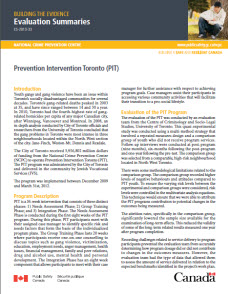
|
Prevention Intervention Toronto (PIT)
|
This Evaluation Summary provides final findings from the Prevention Intervention Toronto (PIT) program. The PIT program was designed to help address the issues of Toronto youth becoming involved in gangs.
| 2013-10-10 |
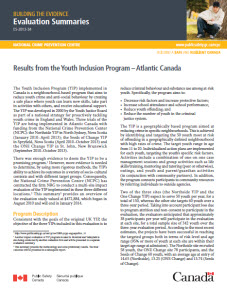
|
Results from the Youth Inclusion Program – Atlantic Canada
|
This Evaluation Summary provides preliminary findings from the three trials of the Youth Inclusion Program (YIP) being implemented to reduce youth crime and anti-social behaviour in Atlantic Canada.
| 2013-10-10 |

|
Results from the Towards No Drug Abuse (TND) Project
|
This Evaluation Summary provides preliminary findings from the Towards No Drug Abuse (TND) program being implemented in the Hamilton Wentworth District School Board in Ontario. The TND program is being implemented to determine if it can contribute to changes in drug abuse patterns among youth.
| 2013-10-10 |

|
Results from the Multisystemic Therapy Program
|
This Evaluation Summary provides preliminary findings from the Multi-Systemic Therapy (MST) program being implemented to address aggressive and socially unacceptable behaviour among at-risk youth in the Scarborough District of Toronto, Ontario.
| 2013-10-10 |
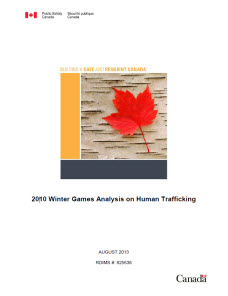
|
2010 Winter Games Analysis on Human Trafficking
|
The Global Alliance Against Traffic in Women (GAATW) Canada was established in 1996 in Victoria, BC and is a member organization of GAATW whose International Secretariat is located in Bangkok, Thailand. It constitutes an alliance of over 105 non-governmental organizations worldwide, which include women's rights, human rights, migrant rights, and anti-trafficking organizations, as well as self-organized groups of migrant workers, domestic workers, sex workers, and survivors of human trafficking.
| 2013-09-19 |

|
From Small Demonstration Project to Large-scale Implementation
|
What considerations are important when going from a demonstration project to large-scale implementation?
| 2013-09-01 |
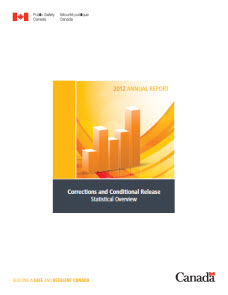
|
2012 Corrections and Conditional Release Statistical Overview
|
This document provides a statistical overview of corrections and conditional release within a context of trends in crime and criminal justice. A primary consideration in producing this overview was to present general statistical information in a "user friendly" way that will facilitate understanding by a broad audience.
| 2013-08-13 |

|
Canada's Anti-Human Trafficking Newsletter - Issue 3, July 2013
|
Canada's Anti-Human Trafficking Newsletter - Issue 3, July 2013
| 2013-08-06 |

|
Risk and Mentally Disordered Offenders
|
Are the risk factors for mentally disordered offenders different than for non-disordered offenders?
| 2013-07-31 |

|
Guidelines for a Community Consultative Group
|
These guidelines have been designed to help volunteers from First Nation and Inuit communities participate in and contribute to the delivery of dedicated and culturally responsive police services in communities across Canada.
| 2013-07-31 |

|
Organized Crime Research Highlights Number 4
|
Internet-facilitated Counterfeit Crime; Violence and Gang Territories; Measuring Police Impact on Organised Crime; Locating Meth Labs; Strategic Intelligence and Transnational Organised Crime; Sizing Drug Markets using Sewage.
| 2013-07-18 |

|
National Joint Committee of Senior Criminal Justice Officials Annual Report 2012-2013
|
This report highlights the key activities and achievements of the NJC and its regional committees (Atlantic, Quebec, Ontario, Prairies, and Pacific regions).
| 2013-07-08 |

|
Arrest Without Warrant: Handbook for Front-line Peace Officers 2013
|
This instructive handbook is an initiative of Public Safety Canada and the National Joint Committee of Senior Criminal Justice Officials (NJC) in response to newly introduced amendments to the Corrections and Conditional Release Act (CCRA) brought about by the Safe Streets and Communities Act.
| 2013-06-20 |

|
Summit on the Economics of Policing - Summit Report
|
On January 16-17, 2013, the Minister of Public Safety, on behalf of all Federal, Provincial and Territorial (FPT) Ministers Responsible for Justice and Public Safety, hosted the Summit on the Economics of Policing in Ottawa, Canada. This report provides a record of the proceedings, highlights key insights and observations, and outlines the proposed framework for policing in Canada.
| 2013-06-06 |

|
Screening Volunteers for the Risk of Child Sexual Abuse
|
How can volunteer organizations identify applicants at risk for committing child sexual abuse?
| 2013-05-01 |

|
Attitudes supportive of sex offending predict recidivism
|
Do attitudes supportive of sex offending predict recidivism among sexual offenders?
| 2013-03-01 |
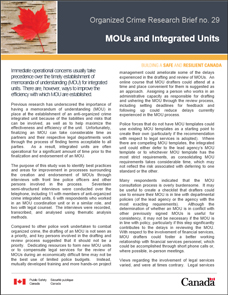
|
MOUs and Integrated Units (OCRB no. 29)
|
The purpose of this study was to identify best practices and areas for improvement in processes surrounding the creation and endorsement of MOUs through interviews with front line police officers and other persons involved in the process. Key findings: Immediate operational concerns usually take precedence over the timely establishment of memoranda of understanding (MOU) for integrated units. There are, however, ways to improve the efficiency with which MOU are established.
| 2013-02-12 |

|
Prescription Drug Return Initiatives in Canada
|
This document identifies examples of initiatives, mostly Canadian, to reduce the harms related to the illicit use and disposal of pharmaceuticals, with a specific focus on awareness-raising.
| 2013-02-12 |

|
Stop Now And Plan (SNAP®) Projects
|
What have we learned about implementing the Stop Now And Plan (SNAP®) Program across Canada?
| 2013-02-01 |

|
Canada's Anti-Human Trafficking Newsletter - Issue 2, February 2013
|
Canada's Anti-Human Trafficking Newsletter - Issue 2, February 2013
| 2013-02-01 |

|
Predicting recidivism with aboriginal offenders
|
Do the Central Eight risk/need factors predict recidivism with Aboriginal offenders?
| 2013-01-01 |

|
Data mining for Possible Organized Crime (OCRB no. 28)
|
This study combined computational mathematical analysis, social network analysis methods, and data mining techniques in a unique way to automatically identify traces of possible criminal organizations in operational police records. Key findings: A method of data mining regular police records to identify possible criminal organizations has been developed. Between 2001 and 2006, offending related to 236 possible criminal organizations was reported to RCMP "E" Division, with 39 of the groups being particularly serious.
| 2012-11-05 |

|
"What Works" in Drug Treatment Courts
|
How do the principles of effective correctional intervention apply in drug treatment courts?
| 2012-11-01 |

|
Criminal Trajectories of Ontario Adjudicated Youths
|
What are the long-term trends in criminal activity, and the factors associated with the course of offending, of adolescent male offenders in Ontario?
| 2012-11-01 |

|
The Screening Handbook 2012 Edition
|
The 2012 Edition of The Screening Handbook was created to provide organizations with up-to-date information, tools, and resources to support comprehensive, ongoing screening policies and practices. It is important to understand that "the primary issue related to screening is what people are called upon to do, for whom, and under what circumstances, not whether they are paid or not paid for their efforts." While the material may be useful for organizations engaging paid employees, interns, placement students, and community service participants, the intended purpose is to build awareness and capacity for screening volunteers.
| 2012-10-17 |

|
Implementation Fact Sheets on Promising and Model Crime Prevention Programs - 2012
|
Implementation Fact Sheets on Promising and Model Crime Prevention Programs - 2012
| 2012-10-01 |

|
Canada's Anti-Human Trafficking Newsletter - Issue 1, October 2012
|
Canada's Anti-Human Trafficking Newsletter - Issue 1, October 2012
| 2012-10-01 |

|
Velocity Adventure Program (CPA-26)
|
The Velocity Adventure Program (Velocity) is an adventure-based program for youth who are at risk of, or have already been involved in, criminal activity.
| 2012-09-13 |

|
Cognitive-Behavioural Interventions in Community Supervision
|
How well do community supervision officers target procriminal attitudes/cognitions in one-on-one sessions with their clients?
| 2012-09-01 |

|
National Joint Committee of Senior Criminal Justice Officials - Annual Report 2011-2012
|
This report highlights the key activities and achievements of the NJC and its regional committees (Atlantic,Quebec, Ontario, Prairie, and Pacific regions).
| 2012-08-14 |

|
Guidelines for Agents and Peace Officers designated by the Minister of Public Safety Canada (PS)
|
The purpose of this guide is to provide assistance to designated agents and peace officers in the fulfilment of their duties and reporting obligations under the Invasion of Privacy provisions of the Criminal Code.
| 2012-08-10 |

|
The Offending Trajectories of Youth Probationers from Early Adolescence to Middle Adulthood: Relation to Dual Taxonomies
|
This study sought to identify the distinctive criminal pathways, and specify the early characteristics that predict offending trajectories for a Canadian sample comprised of 514 male and female juvenile probationers followed into middle adulthood.
| 2012-07-12 |

|
Promising Practices in Policing Substance Users: A Handbook of Integrated Models and Practices
|
This handbook, based on a research report commissioned by Public Safety Canada in collaboration with the Canadian Association of the Chiefs of Police Drug Abuse Committee, identifies promising practices in integrated approaches to policing substance users.
| 2012-07-06 |

|
Risk Assessment For Aboriginal Sex Offenders
|
Do the same risk factors apply to Aboriginal and non-Aboriginal sex offenders?
| 2012-07-01 |
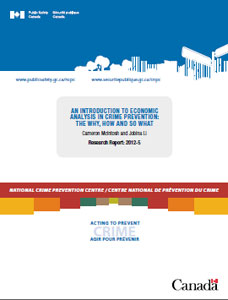
|
An Introduction to Economic Analysis in Crime Prevention: The Why, How and So What
|
An Introduction to Economic Analysis in Crime Prevention: The Why, How and So What
| 2012-07-01 |

|
Risk factors associated with conduct disorder
|
What are the late childhood risk factors associated with conduct disorder in early adolescence, and how are these risk factors specific to particular categories of conduct disorder?
| 2012-07-01 |

|
Organized Crime Research Highlights Number 3
|
How identities are traded online; Differences between organized criminals and other offenders; White-collar crime and the global financial meltdown; Combating transnational environmental crime; Co-offending between criminal enterprise groups; Using math to estimate the gang affiliation of unknown offenders; Comparing the illicit trades in wildlife and drugs.
| 2012-06-25 |
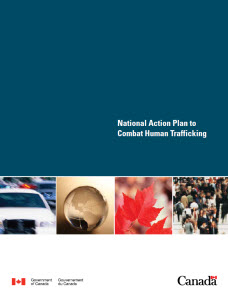
|
National Action Plan to Combat Human Trafficking
|
As part of our Government's longstanding commitment to protect the vulnerable, tackle crime and safeguard Canadians and their families in their homes and communities, we are taking action against these terrible crimes.
| 2012-06-06 |

|
Durham Youth Gang Strategy
|
In response to the growing gang problem in Durham, the National Crime Prevention Centre, provided $1.5 million to launch the Durham Youth Gang Strategy.
| 2012-06-01 |
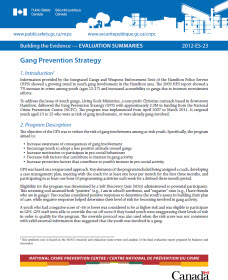
|
Gang Prevention Strategy
|
To address the issue of youth gangs, Living Rock Ministries, a non-profit Christian outreach based in downtown Hamilton, delivered the Gang Prevention Strategy (GPS) with approximately 2.3M in funding from the National Crime Prevention Centre.
| 2012-06-01 |

|
Pilot Project to Implement the Looking After Children (LAC) Approach in Québec
|
The Looking After Children project was funded by the National Crime Prevention Centre between March 2004 and February 2009.
| 2012-06-01 |

|
Regina Anti-Gang Services
|
Regina Anti-Gang Services (RAGS) was developed in 2007 in response to the high level of gang activity in the North Central neighbourhood of Regina.
| 2012-06-01 |

|
The Surrey Wraparound: A Youth Driven Plan for Gang Violence Prevention
|
In 2008, the National Crime Prevention Centre's Youth Gang Prevention Fund awarded $808,000 to Surrey School District #36 to implement the Surrey Wrap program.
| 2012-06-01 |

|
Winnipeg Youth Gang Prevention Fund
|
In 2007, Public Safety Canada's National Crime Prevention Centre provided, through its Youth Gang Prevention Fund (YGPF), $2,192,857 in funding to five community-based projects in Winnipeg to deliver services and support to gang-involved youth and those at risk of gang involvement over a three-year period ending March 31, 2011.
| 2012-06-01 |

|
Youth Advocate Program
|
In response to the increased level of gang-related activity, HRM applied to the National Crime Prevention Centre (NCPC) Youth Gang Prevention Fund (YGPF) and subsequently received 1.9 million in funding to implement the Youth Advocate Program (YAP) from 2008-2011.
| 2012-06-01 |

|
Youth Alliance Against Gang Violence
|
In April of 2007, the National Crime Prevention Centre (NCPC) awarded $1,657,141 under the Youth Gang Prevention Fund (YGPF) to the Prince Albert Outreach Program Inc. (PAOPI), a registered non-profit charitable organization, to implement and evaluate the Youth Alliance against Youth Violence program .
| 2012-06-01 |

|
Youth At Risk Development
|
In response to growing concerns about gang violence, the Youth At Risk Development program offered prevention services to high-risk youth and youth involved in gang-related activities in Calgary, Alberta.
| 2012-06-01 |

|
Marginalized: The Aboriginal Women's experience in Federal Corrections
|
Marginalized: The Aboriginal Women's experience in Federal Corrections
| 2012-05-23 |

|
Assessing the Risk of Gang Members
|
Do gang members vary in their risk to commit crime?
| 2012-05-01 |

|
Predicting Recidivism with Street Gang Members
|
The objective of this research is to examine the applicability of the LS/CMI (Andrews, Bonta, & Wormith, 2004) to gang members and to identify specific criminogenic needs profiles compared to non-gang offenders.
| 2012-04-17 |

|
A Statistical Snapshot of Youth at Risk and Youth Offending in Canada NCPC
|
Juvenile delinquency is a complex, multi-faceted issue. In order to devise effective prevention and intervention strategies for youth at risk, it is important to understand the context in which this behaviour occurs.
| 2012-04-16 |

|
The spatial distribution of police-reported youth crime in Toronto
|
How is youth crime distributed in Toronto, and what are the neighbourhood characteristics most strongly associated with this distribution?
| 2012-04-01 |

|
L'Allié: A multimodal approach to remedy behavioural problems and prevent violence in schools
|
L'Allié is a multimodal intervention program intended for students aged 8 to 12 (in Grades 3 to 6 of elementary school) who exhibit externalized behavioural problems, and are at a high risk of school and social maladjustment.
| 2012-03-29 |

|
Late Childhood Risk Factors Associated with Conduct Disorder Subtypes in Early Adolescence: A Latent Class Analysis of a Canadian Sample
|
Very few studies have investigated the association between risk factors in late childhood and subtypes of conduct disorder (CD) in early adolescence that comprise such heterogeneous symptoms as aggression, destruction of property, theft and serious violations of rules.
| 2012-03-28 |

|
Identification and Operationalization of the Major Risk Factors for Antisocial and Delinquent Behaviour among Children and Youth NCPC
|
The objective of this report was to conduct a thorough review of the literature to identify the major risk factors for the onset and maintenance of antisocial and delinquent behaviour in children and adolescents.
| 2012-03-26 |

|
Bamboo Shield (CPA-25)
|
The Bamboo Shield program works with high-risk Aboriginal and immigrant youth between 13 and 17 years old in three schools in Edmonton, Alberta schools.
| 2012-03-23 |

|
Criminal Trajectories of Two Subsamples of Adjudicated Ontario Youths
|
This report presents the findings of three studies conducted on two subsamples of adjudicated Ontario youth. The objective of the studies was twofold: (1) to examine the criminal trajectories of the two subsamples over several follow-up periods; and (2) to identify childhood predictors and adolescent correlates of trajectory group membership.
| 2012-03-09 |

|
Combining Risk Assessment Tools
|
How should we combine the results of different offender risk assessment tools?
| 2012-03-01 |

|
Organized Crime Research Highlights Number 2
|
Criminal cooperation between organized crime groups; Do all gangs pose equal security risks in correctional facilities? ; Motives and methods for leaving a gang; Who stops dealing hard drugs?; Using wiretap data to understand criminal organizations; Effectively dismantling a drug syndicate using network structure and role; and Organized crime involvement in the illicit antiquities trade.
| 2012-02-24 |
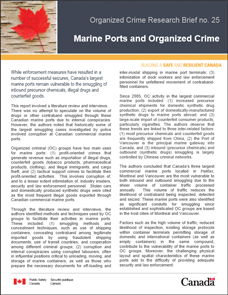
|
Marine Ports and Organized Crime (OCRB no. 25)
|
Through the literature review and interviews, the authors identified methods and techniques used by OC groups to facilitate their activities in marine ports. Key findings: While enforcement measures have resulted in a number of successful seizures, Canada's largest marine ports remain vulnerable to the smuggling of inbound precursor chemicals, illegal drugs and counterfeit goods.
| 2012-02-16 |

|
Securities and Organized Crime (OCRB no. 26)
|
This report is based on a review of the academic literature, interviews with law enforcement, and securities regulators, and legislation and regulations governing Canadian securities markets. Key findings: Evidence of traditional organized crime in securities markets is scarce, but the industry is vulnerable to fraudulent activity perpetuated by market insiders.
| 2012-02-16 |

|
Commercial Construction and Organized Crime (OCRB no. 27)
|
This report is based on a literature review, interviews and a descriptive analysis of economic data from the commercial construction sector in British Columbia and Quebec. Key findings: The economic and regulatory environment in which the Canadian commercial construction sector operates is at moderate to high risk of corruption and organized criminal activity.
| 2012-02-16 |

|
Canada's Role in the Global Meth Market (OCRB no. 23)
|
This research represents a first step towards discovering a more reliable measurement of Canada's role as a producer and exporter in the global ATS market. Key findings: According to preliminary estimates, Canada produces 0.6 – 4.6% of the world's supply of amphetamine-type stimulants, including ecstasy. This finding suggests that Canada is not a major global exporter of amphetamine-type stimulants.
| 2012-02-13 |

|
From Case Management to Change Agent: The Evolution Of 'What Works' Community Supervision
|
In this article, we define what cognitive-behaviourism looks like in a criminal justice context and how it can be used to maximize the impact of community supervision. Through the amalgamation of cognitive-behavioural techniques and risk/need information, we propose the use of a theoretically and empirically-based framework (i.e., the STICS Action Plan) to assist community supervision officers in planning, prioritizing and effectively achieving change with their clients.
| 2012-01-31 |

|
2011 Corrections and Conditional Release Statistical Overview
|
This document provides a statistical overview of corrections and conditional release within a context of trends in crime and criminal justice. A primary consideration in producing this overview was to present general statistical information in a "user friendly" way that will facilitate understanding by a broad audience.
| 2012-01-19 |

|
Effective Prison Management
|
What steps can be taken to more effectively manage prisons?
| 2012-01-01 |

|
A General Overview of Economic Analyses in Crime Prevention
|
How can decision-makers determine the most efficient and cost-effective ways to prevent and reduce crime and victimization?
| 2012-01-01 |

|
MY Regent Park (CPA-20)
|
The MY Regent Park project (Mentoring, Mobilizing Youth in Regent Park)works towards the reduction and prevention of gang activity in the Regent Park community of downtown Toronto.
| 2011-11-09 |

|
Illicit Use of Pharmaceuticals Workshop
|
The following report contains summaries of the presentations and discussions that occurred during the "Illicit Use of Pharmaceuticals" Workshop that was hosted by Public Safety Canada on June 2-3 2011.
| 2011-11-07 |

|
Organized Crime Research Highlights Number 1
|
Social Network Analysis in Operations; Current Proposed Australian Unexplained Wealth Regimes; Criminal Trajectories in Organized Crime; Mortgage Origination Fraud and the Global Economic Crisis; More Organizationally Complex Gangs: Committing More Crime?; Traffic in Garbage and Hazardous Waste: An Overview; Precursor Laws Effect on Methamphetamine Production
| 2011-11-03 |

|
The Offending Trajectories of Canadian Juvenile Probationers
|
Can we identify the criminal pathways and characteristics of Canadian youths who are responsible for the vast majority of all offences and the most serious types of crime?
| 2011-11-01 |

|
Witness Protection Programs (OCRB no. 1)
|
This review compared the characteristics and operations of witness protection in selected countries, as well as the successes and challenges they face. Key Findings: Around the world most witness protection programs are managed by police forces. Witness intimidation is usually perpetrated by criminal organizations. Most protected witnesses are criminally-involved.
| 2011-10-28 |

|
POP and Securities Fraud (OCRB no. 2)
|
The authors of this report outlined a problem-oriented approach to securities fraud and considered the involvement of organized crime in such offenses. Key findings: Problem-oriented policing (POP) has not been systemically applied to securities fraud in Canada. Offenders are generally white, well-educated males who specialize in white-collar crime, and who move often. Seniors are common victims; people are often repeatedly victimized.
| 2011-10-28 |

|
Sizing Meth and MDMA Markets (OCRB no. 3)
|
The purpose of this report was to re-examine the scientific and grey literature on current methods of estimating the size of illegal markets, with an emphasis on the meth/MDMA markets. Key findings: There are no good estimates of the size of Canadian meth and ecstasy markets. Multiplier and capture-recapture methods may be able to estimate number of users and sellers, as well as quantity consumed and exported.
| 2011-10-28 |

|
Mobility of Criminal Groups (OCRB no. 4)
|
This report examined the findings from past research that posited themes and theories regarding the shifts and patterns in the mobility of criminal groups. Key findings: Criminal groups are more self-organizing and emergent than strategic when setting up in new locations. Preventing criminal opportunities can stifle the migration of organized crime.
| 2011-10-28 |

|
POP and Outdoor Cannabis (OCRB no. 5)
|
The purpose of this report was to outline how the principles of POP might be applied to disrupting and preventing the operation of outdoor marijuana grow operations (OMGOs) controlled by organized crime groups within Canada. Key findings: As with indoor grow operations, particular resources and circumstances are required for growing cannabis outdoors. Understanding offending patterns can lead to novel suppression and disruption strategies.
| 2011-10-28 |

|
Counter-measure Effects (OCRB no. 6)
|
This report expanded on the body of research on organized crime (OC) counter-measures and reviewed how law enforcement operations targeting organized crime are evaluated. Key findings: Police operations against organized crime have limited to no measurable impact on the public's perception of safety or recorded levels of crime at the city-wide level.
| 2011-10-28 |

|
Factors Shaping Organized Crime (OCRB no. 7)
|
This report assessed a number of individual, group, and environmental level variables that may influence how individuals or groups structure their criminal operations in a variety of criminal markets and legitimate settings. Key findings: The structure of organized crime can tell us about available criminal opportunities and criminal operations, as well as the enforcement environment. Group structure is a result of external factors, mitigated by individual resources and decision making.
| 2011-10-28 |

|
Integrated Anti-Organized Crime Units (OCRB no. 8)
|
The purpose of this study was two-fold: (a) compilation of a current inventory of all integrated teams and units operating in Canada; and (b) a more detailed qualitative analysis of a subset of these units to better understand their operating procedures, challenges, and keys to success. Key findings: As of 2009, there were 157 integrated organized crime units. Clarity and consistency on the roles and responsibilities of partners and team members is the key to their success.
| 2011-10-28 |

|
Literature Review on Organized Crime (OCRB no. 9)
|
This report examined academic research being conducted world-wide on addressing organized crime, as of 2009. Key findings: Organized crime largely exists due to illicit markets. The application of violence by organized crime is cyclical. There is no consensus on how to measure the harm of organized crime.
| 2011-10-28 |

|
Training Needs to Combat Organized Crime (OCRB no. 10)
|
This report provided an understanding of the perspectives of policy makers, prosecutors, and law enforcement personnel regarding most urgent training requirements, as well as their suggestions for future training which would assist them with identifying and conducting intelligence on, and prosecuting those engaged in, organized criminal activities. Key findings: Shared experience and information makes for effective training. Cross-institutional and co-training models are promising. Introductory courses and seminar series are suggested.
| 2011-10-28 |

|
Creating an Organized Crime Harm Index (OCRB no. 11)
|
The primary goal of this study was to assess the feasibility and utility of developing and applying rigorous methodological and analytical models that could reliably measure the harm of organized crime in Canada. Key findings: Insufficient quantifiable data exists to reliably measure the scope and harm of organized crime in Canada. Detailed self-reported victimization data and data on illicit markets are required. Proxy estimates or indicators may be useful.
| 2011-10-28 |

|
Defining Street Gangs (OCRB no. 12)
|
The primary purpose of this report was to discuss the difficulties related to the identification of gang members and gang-related crimes in Canada, and provide an overview of how gangs have been previously defined by academic researchers, law enforcement agencies and government policy-makers. Key findings: Many different definitions of "gang" and "street gang" are in use. Differences can hinder gang suppression and prevention activities. A proposed, common ground definition is nearly identical to the "criminal organization" definition in the Criminal Code of Canada.
| 2011-10-28 |

|
Gangs and Social Networking (OCRB no. 13)
|
The main purpose of this report was to explore how social media can assist in understanding the functioning and activities of criminal groups, the magnitude of the current and future threats posed by such groups' usage of new communications technology, and potentially provide a reasonable set of options for combating this problem. Key findings: Gang members generally use social networking sites individually to promote gang culture or individual reputations, not to collectively arrange offending or recruit members. Law enforcement monitoring of social networking sites is useful for policing gangs.
| 2011-10-28 |

|
Addressing Street Gangs (OCRB no. 14)
|
The goal of this report was to present some ideas about the best ways to deal with street gangs in Canada. Key findings: Comprehensive gang crime reduction strategies target crime with prevention, intervention and suppression efforts. Single strategy programs have been of limited effectiveness.
| 2011-10-28 |
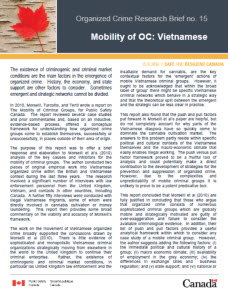
|
Mobility of Organized Crime: Vietnamese (OCRB no. 15)
|
The goal of this report was to present some ideas about the best ways to deal with street gangs in Canada. Key findings: Comprehensive gang crime reduction strategies target crime with prevention, intervention and suppression efforts. Single strategy programs have been of limited effectiveness.
| 2011-10-28 |

|
Mobility of Organized Crime: Cammora (OCRB no. 16)
|
The purpose of this report was to test framework of Morselli, Turcotte, and Tenti against a recent case study on the movement of a Camorra crime group from Campania (Italy) to Scotland and the Netherlands. Key findings: Organized crime groups that are predatory or provide an illicit good or service transpose their operations differently, and for different reasons. Varied types of movement - of individuals, branches, or headquarters - require separate consideration.
| 2011-10-28 |
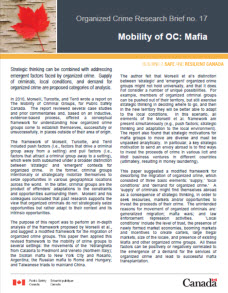
|
Mobility of Organized Crime: Mafia (OCRB no. 17)
|
The purpose of this report was to perform an in-depth analysis of the framework proposed by Morselli et al., and suggest a modified framework for the migration of organized crime groups. Key findings: Strategic thinking can be combined with addressing emergent factors faced by organized crime. Supply of criminals, local conditions, and demand for organized crime are proposed categories of analysis.
| 2011-10-28 |

|
Street Gang Control Strategies (OCRB no. 18)
|
This report involved a systematic literature review as well as an attempted meta-analysis of evalutations of street gang control strategies. Key findings: Not enough empirical evaluations have been done of gang control strategies to perform a statistical meta-analysis. Programs are more effective when they are directed at specific populations, particularly chronic gang members. The empirical effectiveness of the Spergel Model is questioned.
| 2011-10-28 |

|
Ways to Measure Cyber-Fraud (OCRB no. 19)
|
The primary goals of this study were to assess the potential for using innovative methodologies to estimate the scope of cyber-fraud, to identify existing data sources and gaps, and to suggest novel sources of data that may help provide an accurate and fulsome picture of the nature and prevalence of cyber-fraud in Canada. Key findings: Cyber-fraud data is collected by a variety of organizations, including banks, regulatory agencies, and various police agencies. Often it is not collected at all. A study of offender network structures could be applied to methods of identifying hidden populations of cyber-fraud offenders.
| 2011-10-28 |

|
Understudied Areas of Orgranized Crime (OCRB no. 20)
|
Understudied areas of organized crime include how organized crime groups spend their money, environmental crime, wildlife crime, organized crime infiltration in legitimate enterprises and markets, the counterfeiting of goods, and online gambling. Key findings: Understudied areas of organized crime include how organized crime groups spend their money, environmental crime, wildlife crime, organized crime infiltration in legitimate enterprises and markets, the counterfeiting of goods, and online gambling.
| 2011-10-28 |

|
Social Media and Organized Crime (OCRB no. 21)
|
This research complements existing empirical information regarding the use of social media by criminal organizations and by police by way of literature review and interviews with police and social media experts. Key findings: Persons suspected of organized crime involvement do not tend to display their illicit activities on their social media profiles, but instead use social media to keep connected to their friends, families, and to share their interests. Police, on the other hand, employ social media to connect to the communities that they serve and as an investigative tool.
| 2011-10-28 |
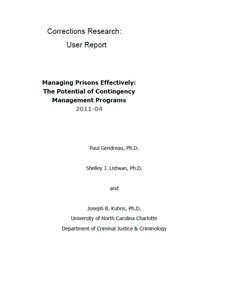
|
Managing Prisons Effectively: The Potential of Contingency Management Programs
|
This study draws attention to a long forgotten prison treatment literature known as contingency management (e.g., token economies) which has the potential to meet the goals of an "accountability" management perspective. The contingency management (CM) literature was reviewed to assess its potency for improving inmates' performance (e.g., prison adjustment, educational/work skills) and to generate a list of principles nominated by experts in the area for managing CM programs effectively.
| 2011-09-14 |

|
Strengths And Human Needs In Offender Rehabilitation
|
What is the role played by strengths and basic human needs in the rehabilitation of offenders?
| 2011-09-01 |

|
The Treatment of Incarcerated Mentally Disordered Women Offenders: A Synthesis of Current Research
|
This synthesis of the research evidence in relation to the treatment of mentally disordered women offenders is prompted by recent reviews of correctional practice in the Canadian federal correctional system, and the growing awareness of the impact research can have on programs for women within the correctional system.
| 2011-08-10 |
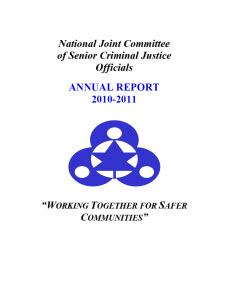
|
National Joint Committee of Senior Criminal Justice Officials Annual Report 2010-2011
|
This report describes the main activities and achievements of the NJC and its regional committees (the Atlantic, Quebec, Ontario, Prairies and Pacific regions).
| 2011-07-25 |

|
Internet Sexual Offenders
|
How often do men who commit sexual offences online also commit contact sexual offences?
| 2011-07-01 |

|
Families at risk: The impact of the familial environment on juvenile delinquency
|
What are the factors within the family environment that contribute to, or prevent, juvenile delinquency?
| 2011-07-01 |
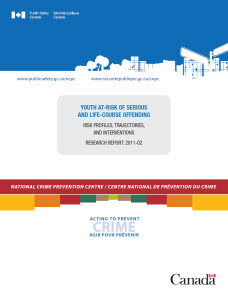
|
Youth At-Risk of Serious and Life-Course Offending
|
This report is based on a review of relevant risk factors that must be taken into consideration when applying interventions to prevent, reduce, or respond to youth at risk of serious and life-course offending.
| 2011-06-22 |

|
Better Beginnings, Better Futures Study: Delinquency Trajectories of At-Risk Youth
|
The objectives of the research were to identify early trajectories of delinquency for both boys and girls from age 8 (Grade 3), age 11 (Grade 6), and age 14 (Grade 9) in a longitudinal sample of at-risk youth from a multi-informant perspective, assess risk and protective factors that may influence the likelihood that youth will engage in criminal behaviour in adolescence, and examine whether youth in the identified delinquency trajectories differ substantially in terms of delinquency, involvement with the criminal justice system, emotional and behavioural problems, experience of abuse, academic/school functioning, and health/health risk behaviours.
| 2011-06-22 |
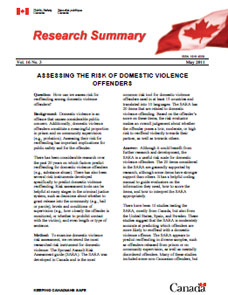
|
Assessing The Risk Of Domestic Violence Offenders
|
How can we assess risk for reoffending among domestic violence offenders?
| 2011-05-01 |

|
Promising and Model Crime Prevention Programs - Volume II
|
Promising and Model Crime Prevention Programs - Volume II
| 2011-05-01 |

|
Risk Factors for Delinquency among Canadian Youth: Current knowledge and future directions
|
This paper synthesizes existing knowledge from Canadian studies that address delinquency-related risk factors.
| 2011-05-01 |

|
The CRACOW: A Multi-stage Risk/Needs Instrument for Youth
|
Can the CRACOW accurately and reliably assess the risk and needs of multi-problem youth during the early years of development?
| 2011-04-01 |

|
Better to Build a Child than fix an Adult
|
A Report on the Predictors of Risk for Youth Who Proceed to the Adult Justice System and the Programs that Work to Reduce that Likelihood
| 2011-03-31 |

|
The CRACOW Instrument: A New Framework for the Assessment of Multi-problem Violent Youth
|
The current study examined a revised version of the CRACOW, a risk/needs instrument for multi-problem violent youth in early childhood which was first proposed by Corrado (2002).
| 2011-03-26 |

|
Family Adolescent Straight Talk (FAST) - Day Suspension Program
|
Family Adolescent Straight Talk (FAST) is an outpatient treatment centre in Halton Region, Ontario, that helps adolescents and families in crisis. FAST's services include crisis intervention, adolescent assessment, psychological and addictions counselling, parent counselling, anger and stress management programs, and relapse prevention programs.
| 2011-03-15 |

|
The RRASOR, Static-99R and Static-2002R All Add Incrementally to the Prediction of Recidivism among Sex Offenders
|
The current study examined the predictive accuracy and incremental validity of three risk assessment scales (RRASOR, Static-99R, and Static2002R) in twenty distinct samples of sex offenders (N = 7,491).
| 2011-03-09 |

|
Assessing the Risk of Older Sex Offenders: Developing the Static-99R and Static-2002R
|
The current study aimed to develop a revised scoring system for two risk assessment tools (Static-99 and Static-2002) that would more accurately describe older offenders' risk of recidivism.
| 2011-03-02 |

|
Addressing the Needs of Offenders
|
What offender needs should be addressed by treatment programs?
| 2011-03-01 |

|
Abbotsford Youth Crime Prevention Project (CPA-22)
|
The Abbotsford Youth Crime Prevention Project works with two distinct groups of youth in Abbotsford, British Columbia.
| 2011-02-21 |

|
Effective Community Response to Immigrant Youth Gang Crime (CPA-21)
|
The Effective Community Response to Immigrant Youth Gang Crime Prevention Project provides a comprehensive approach to understanding and reducing the involvement of immigrant youth in gang criminal activity in Calgary.
| 2011-02-21 |

|
Waterloo Regional Gang Prevention Project (CPA-24)
|
The Waterloo Regional Gang Prevention Project is implementing a comprehensive and integrated strategy to address and prevent gang activity among youth in the Waterloo Region.
| 2011-02-21 |

|
ARCHIVE - "Emerging Issues in Drug Enforcement" Workshop
|
These proceedings contain a summary of the presentations and the dialogue held during the 2010 Emerging Issues in Drug Enforcement Workshop.
| 2011-01-24 |

|
Measuring Crime in Canada
|
How are statistics regarding the criminal justice system in Canada gathered and reported?
| 2011-01-01 |

|
Tools to Identify and Assess the Risk of Offending Among Youth
|
Can tools to identify and assess the risk of offending among youth be used and even recommended as part of prevention programs?
| 2011-01-01 |

|
2010 Corrections and Conditional Release Statistical Overview
|
This document provides a statistical overview of corrections and conditional release within a context of trends in crime and criminal justice. A primary consideration in producing this overview was to present general statistical information in a "user friendly" way that will facilitate understanding by a broad audience.
| 2010-12-31 |

|
Giving Meaning to Risk Factors
|
Why do risk factors predict recidivism?
| 2010-11-01 |

|
Guidelines for the Use of Conducted Energy Weapons
|
The purpose of this document is to provide guidance on the use of conducted energy weapons (CEWs).
| 2010-10-07 |

|
ARCHIVE - Identifying Illegal Firearm Market Acquisition Patterns - Final Report
|
This research presents the results of a qualitative survey of 20 incarcerated and nonincarcerated illicit firearm market consumers in Quebec.
| 2010-09-15 |

|
Ensuring the integrity of effective community supervision
|
How can correctional agencies ensure the integrity of effective community supervision?
| 2010-09-01 |

|
Fetal Alcohol Spectrum Disorder and the Criminal Justice System
|
The purpose of this bibliography is to provide sources of research and documentation that focus on justice and medical related issues as they pertain to FASD.
| 2010-07-20 |
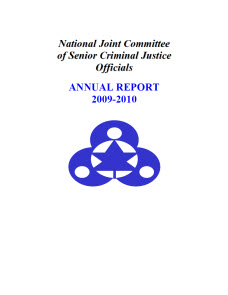
|
National Joint Committee of Senior Criminal Justice Officials Annual Report 2009-2010
|
This report describes the major activities and achievements of the NJC and its regional committees (Atlantic, Quebec, Ontario, Prairies and Pacific).
| 2010-07-20 |

|
The same risk factors predict most types of recidivism
|
Do the same risk factors apply to all types of offenders?
| 2010-07-01 |
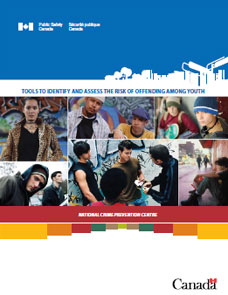
|
Tools to Identify and Assess the Risk of Offending Among Youth
|
This research report presents some of the tools used in the prevention of youth offending.
| 2010-06-01 |

|
Training in evidence-based community supervision
|
Can training improve the effectiveness of community supervision?
| 2010-05-01 |

|
The Strategic Training Initiative in Community Supervision: Risk-Need-Responsivity in the Real World 2010-01
|
In the present study, an RNR-based training program was developed and delivered to probation officers to assist in the direct supervision of offenders under a probation order.
| 2010-04-22 |

|
Programme de suivi intensif de Montréal – Gangs de rue (CPA-03)
|
The Programme de suivi intensif de Montréal – Gangs de rue (Gangs de rue) project works with teenagers and young adults 15-25 years who are involved in or at high risk of becoming involved in criminal gang activity.
| 2010-03-31 |

|
2010 Corrections and Conditional Release in Canada - A General Primer
|
2010 Corrections and Conditional Release in Canada - A General Primer
| 2010-03-30 |

|
Current Practices in Canadian Sexual Abuser Treatment Programs: The Safer Society 2009 Survey
|
This report is a summary of the Canadian findings of the 2009 Safer Society Survey: Current Practices and Emerging Trends in Sexual Abuser Management (McGrath, Cumming, Burchard, Zeoli, & Ellerby, 2010).
| 2010-03-30 |

|
ARCHIVE - Delivering Change The RCMP Reform Implementation Council Fourth Report
|
RCMP reform is now entering its second phase. The RCMP's focus on the specific recommendations of the 2007 Task Force on Governance and Cultural Change in the RCMP is now giving way to a new approach of promoting continuous change throughout the Force.
| 2010-03-01 |
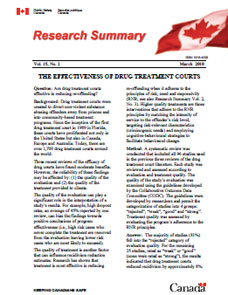
|
The Effectiveness of Drug Treatment Courts
|
Are drug treatment courts effective in reducing re-offending?
| 2010-03-01 |
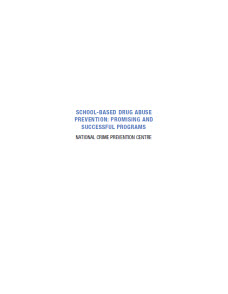
|
School-Based Drug Abuse Prevention: Promising and Successful Programs
|
School-Based Drug Abuse Prevention: Promising and Successful Programs
| 2010-01-27 |

|
Restorative justice's impact on participant health
|
Is restorative justice good for participants' health?
| 2010-01-01 |

|
The Investigation, Prosecution and Correctional Management of High-Risk Offenders: A National Guide
|
This guide has been prepared to provide police, prosecution, correctional and other criminal justice officials with an overview of the Criminal Code provisions designed to respond to sexual predators and other high-risk offenders.
| 2009-12-06 |

|
The Aboriginal EMPATHIC Program
|
The Aboriginal Emotional Maturity Problem-Solving & Awareness Targeting Higher Impulse Control (EMPATHIC) Program is a school-based curriculum designed for students in grades one to five.
| 2009-12-04 |

|
Soccer Moms are Part of the Solution "A Cost-Benefit Analysis of a Volunteer-Based Gang Prevention Initiative"
|
The research presented here begins with a case study of community mobilization that took place in Edmonton, Alberta in 2008.
| 2009-12-01 |

|
Drug Treatment Courts: A Quantitative Review of Study and Treatment Quality 2009-04
|
The effectiveness of drug courts has been debated in regards to two main factors: (1) study quality and (2) treatment quality. The current study examined these two factors. Study quality was examined using the Collaborative Outcome Data Committee Guidelines (CODC), and treatment quality was assessed by evaluating adherence to the principles of Risk-Need-Responsivity (RNR). Using the CODC Guidelines, studies were rated as: "rejected", "weak", "good" or "strong" based on methodological quality.
| 2009-12-01 |

|
2009 Corrections and Conditional Release Statistical Overview
|
This document provides a statistical overview of corrections and conditional release within a context of trends in crime and criminal justice. A primary consideration in producing this overview was to present general statistical information in a "user friendly" way that will facilitate understanding by a broad audience.
| 2009-12-01 |

|
Coding Rules for Static-2002
|
Static-2002 is an actuarial risk tool for evaluating the risk of sexual and violent recidivism among adult male sexual offenders (Hanson & Thornton, 2003). Like Static-99, Static-2002 can be used by a wide range of evaluators (e.g., psychologists, probation officers, psychiatrists, therapists) using commonly available criminal history information. Static-2002 predicts sexual, violent, and any recidivism as well as other actuarial risk tools commonly used with sexual offenders (Hanson & Morton-Bourgon, 2009) and slightly better than Static-99 (Hanson, Helmus, & Thornton, in press; Helmus, 2007).
| 2009-12-01 |

|
The Breaking the Cycle Youth Gang Exit and Ambassador Leadership Program
|
The purpose of the evaluability assessment (EA) was to assess and make a determination of whether the BTC program was in a state of program readiness to undergo a rigorous impact and cost-effectiveness evaluation
| 2009-12-01 |

|
Common Ground - An Examination of Similarities between Black & Aboriginal Communities
|
Common Ground - An Examination of Similarities between Black & Aboriginal Communities
| 2009-11-26 |

|
Community Mobilisation Dialogue with Aboriginal Communities
|
The objective of the gatherings was to dialogue with a cross section of First Nations (Ojibwe, Mi'kmaq, Dene, Blackfoot and Kwakitutl) and urban Aboriginal groups about community mobilisation - how it is approached within their regions, the cultural context, and the impact that traditional and cultural approaches have on community mobilisation. A number of common themes were identified.
| 2009-11-01 |

|
The development of aboriginal chronic offending
|
Do Aboriginal offenders follow a similar path to chronic offending as Non-Aboriginal offenders?
| 2009-11-01 |

|
Restorative Justice's Impact on Participants' Psychological and Physical Health 2009-03
|
This study utilized a quasi-experimental, repeated-measures design to assess changes in psychological and physical health in 92 participants (50 victims and 42 offenders) who experienced a restorative justice process. Results indicated that the majority of participants did experience positive changes from pre-program to post-program. Future research directions and limitations are discussed.
| 2009-11-01 |

|
Best Practices for Chronic / Persistent Youth Offenders in Canada
|
This report summarizes information collected on the nature and type of community-based, multi-agency and police strategies and programs that exist across Canada for chronic and persistent youth offenders.
| 2009-11-01 |

|
Risk Assessment Decisions for Violent Political Extremism 2009-02
|
Approaches to risk assessment for violence are described in the document. These include unstructured clinical judgment, actuarial approaches and structured professional judgment (SPJ). Unstructured approaches have been criticized for not demonstrating high validity or good inter-rater reliability.
| 2009-10-01 |

|
A Meta-Analysis of the Effectiveness of Treatment for Sexual Offenders: Risk, Need, and Responsivity 2009-01
|
The current review examined whether the principles associated with effective treatments for general offenders (Risk–Need–Responsivity: RNR) also apply to sexual offender treatment.
| 2009-10-01 |

|
National Joint Committee of Senior Criminal Justice Officials Annual Report 2008-2009
|
This report describes the major activities and achievements of the NJC and its regional committees (Atlantic, Quebec, Ontario, Prairies and Pacific).
| 2009-09-25 |

|
Assessing the risk of violent extremists
|
How should evaluators assess the risk of individuals convicted of offences motivated by extreme political, religious or ideological views?
| 2009-09-01 |

|
Family-based Programs for Preventing and Reducing Juvenile Crime
|
This fact sheet presents family-based programs for preventing and reducing juvenile crime whose effectiveness has been well established by reliable and rigorous evaluation studies.
| 2009-09-01 |
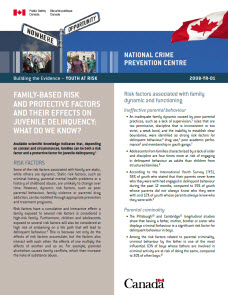
|
Family-Based Risk and Protective Factors and their Effects on Juvenile Delinquency: What Do We Know?
|
Family-Based Risk and Protective Factors and their Effects on Juvenile Delinquency: What Do We Know?
| 2009-09-01 |

|
What To Do With Low Risk Offenders?
|
Do low risk offenders need treatment?
| 2009-07-01 |
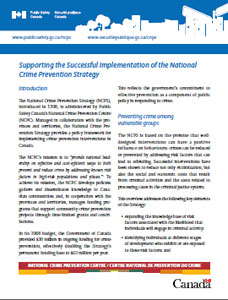
|
Supporting the Successful Implementation of the National Crime Prevention Strategy
|
The National Crime Prevention Strategy (NCPS), introduced in 1998, is administered by Public Safety Canada's National Crime Prevention Centre (NCPC). Managed in collaboration with the provinces and territories, the National Crime Prevention Strategy provides a policy framework for implementing crime prevention interventions in Canada.
| 2009-07-01 |

|
ARCHIVE - Report On The Status Of The Contraband Tobacco Situation In Canada
|
The federal government is interested in advancing efforts to address the issue of contraband tobacco on a national level in collaboration with provincial governments, First Nations communities and industry stakeholders.
| 2009-07-01 |

|
Families, Youth and Delinquency: the State of Knowledge, and Family-based Juvenile Delinquency Prevention Programs
|
Families, Youth and Delinquency: the State of Knowledge, and Family-based Juvenile Delinquency Prevention Programs
| 2009-06-01 |

|
Risk Communication for Offenders
|
How should we report the recidivism risk of offenders?
| 2009-05-01 |

|
Translating 'What Works' into Sustainable Everyday Practice: Program Design, Implementation and Evaluation 2009-05
|
In this report, we describe the challenges and issues that should be addressed when trying to bring research to the real world of community supervision faced by probation officers and we evaluate our efforts to overcome these challenges through STICS.
| 2009-05-01 |

|
What Works For Sexual Offenders?
|
Do the principles of effective intervention for general offenders also apply to treatments for sexual offenders?
| 2009-03-01 |

|
Aboriginal Policing Update 2008
|
Aboriginal Policing Update 2008
| 2009-02-17 |
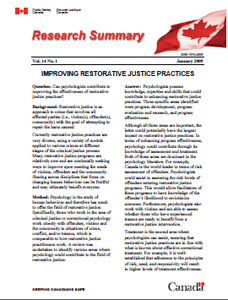
|
Improving Restorative Justice Practices
|
Can psychologists contribute to improving the effectiveness of restorative justice practices?
| 2009-01-01 |

|
2008 Corrections and Conditional Release Statistical Overview
|
This document provides a statistical overview of corrections and conditional release within a context of trends in crime and criminal justice. A primary consideration in producing this overview was to present general statistical information in a "user friendly" way that will facilitate understanding by a broad audience.
| 2008-12-01 |
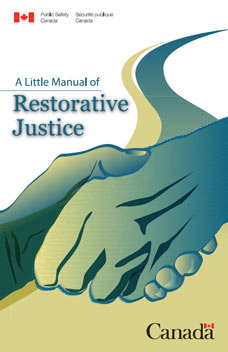
|
A Little Manual of Restorative Justice
|
The little manual wants to put into your hands a basic training tool. The themes addressed in the various modules are themes that the writers\practitioners have found useful in seeking to educate communities about restorative justice and engage citizens in a deeper reflection about the criminal justice system.
| 2008-12-01 |

|
Best Practice Guidelines for Screening Volunteers
|
This booklet outlines the essential steps for screening persons applying to work as volunteers. Organizations should consult the resources at the end of this booklet for more detailed information on how to conduct volunteer screening.
| 2008-12-01 |

|
Community Supervision: Balancing Compliance With Treatment
|
Community Supervision: Balancing Compliance With Treatment
| 2008-09-01 |
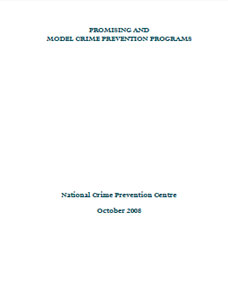
|
Promising and Model Crime Prevention Programs - Volume I
|
This document is part of an ongoing effort at the NCPC to promote and disseminate information and knowledge on effective crime prevention programs, strategies and initiatives.
| 2008-08-01 |

|
Is Denial Always A Problem For Sexual Offenders?
|
What is the relationship between denial and recidivism among sexual offenders?
| 2008-07-01 |
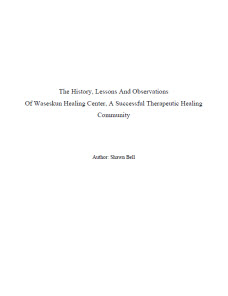
|
The History, Lessons And Observations Of Waseskun Healing Center, A Successful Therapeutic Healing Community
|
This study of the Waseskun Healing Center, encouraged by CSC's recent attempts to translate the Healing Lodge's principles and teachings into the mainstream penitentiary system, set out to examine the workings of Waseskun in order to determine what makes a successful therapeutic healing community.
| 2008-06-11 |
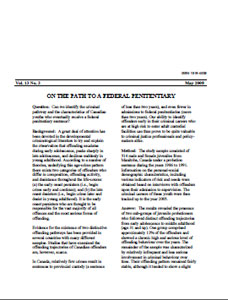
|
On The Path To A Federal Penitentiary
|
Can we identify the criminal pathway and the characteristics of Canadian youths who eventually receive a federal penitentiary sentence?
| 2008-05-01 |

|
Drug Treatment Court of Vancouver (DTCV)
|
The Drug Treatment Court of Vancouver (DTCV) implemented between 2001 and 2005 is based on a model for processing drug addicted offenders that has emerged in the United States and has been adapted to the Canadian context.
| 2008-04-08 |
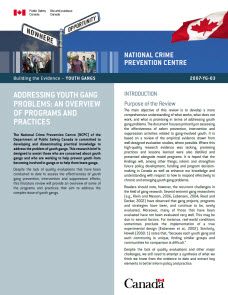
|
Addressing Youth Gang Problems: An Overview of Programs and Practices
|
This research brief is designed to assist those who are concerned about youth gangs and who are working to help prevent youth from becoming involved in gangs or to help them leave gangs.
| 2008-04-01 |
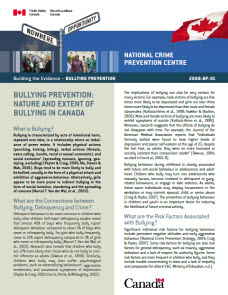
|
Bullying Prevention: Nature and Extent of Bullying in Canada
|
Bullying is characterized by acts of intentional harm, repeated over-time, in a relationship where an imbalance of power exists.
| 2008-04-01 |

|
Middle Schools Project: Families & Schools Together for Children and Neighbourhoods
|
The Middle Schools Project involved implementing the Middle Years F & ST program, an adaptation of the Families and Schools Together (F & ST) model. Middle Years F & ST is aimed at pre-teens (9 to 12 years old) who exhibited risk factors such as family disorganization and isolation, school difficulties, and aggressive behaviour.
| 2008-04-01 |

|
Projet de qualification des jeunes (PQJ)
|
The intensive intervention project (PQJ) to prepare young people for the transition to independent living and ensure that those attending youth centres are qualified is an initiative of the Association des centres jeunesse du Québec.
| 2008-04-01 |

|
Advances in offender risk assessment
|
What progress is being made in the risk assessment of criminal offenders?
| 2008-03-01 |

|
International Comparison of Indigenous Policing Models
|
This paper provides a brief review of current policing programs and initiatives relating to Indigenous peoples in Canada, the United States, Australia and New Zealand.
| 2008-01-23 |

|
Gwich'in Outdoor Classroom Project
|
Gwich'in Outdoor Classroom project was a culture-based crime prevention program in the communities of Fort McPherson and Aklavik, Northwest Territories.
| 2008-01-08 |

|
Healthy Families Project and Kwanlin Dun First Nation's Project
|
The Healthy Families model, which is based on the Healthy Families America program, was tested in five sites across Canada: three sites in Edmonton (Norwood Child and Family Resource Centre, Bent Arrow Traditional Healing Society, and Terra Association), the Kwanlin Dun First Nation Healthy Families Program in Whitehorse, Yukon, and Best Start Healthy Families in Charlottetown, Prince Edward Island.
| 2008-01-08 |

|
Ndaawin Project
|
The Ndaawin Project was a culturally-based intervention aimed at preventing the sexual exploitation of children and youth in Winnipeg.
| 2008-01-08 |

|
The accuracy of risk prediction for intimate partner violence
|
How well can risk assessments predict spousal assault recidivism?
| 2008-01-01 |
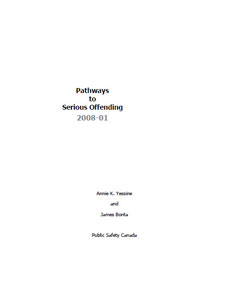
|
Pathways to Serious Offending 2008-01
|
The purpose of this study was to contribute to the growing body of criminological research on the developmental course of crime and expand its scope in various ways.
| 2008-01-01 |

|
ARCHIVE - NJC Bylaws
|
ARCHIVE - NJC Bylaws
| 2007-12-11 |

|
ARCHIVE - Statutes of the National Joint Committee of Senior Criminal Justice Officials
|
ARCHIVE - Statutes of the National Joint Committee of Senior Criminal Justice Officials
| 2007-12-11 |

|
Assessing the risk of sexual offenders on community supervision: The Dynamic Supervision Project
|
Sexual offenders do great societal damage causing justifiable public concern.
| 2007-12-02 |

|
2007 Corrections and Conditional Release Statistical Overview
|
This document provides a statistical overview of corrections and conditional release within a context of trends in crime and criminal justice. A primary consideration in producing this overview was to present general statistical information in a "user friendly" way that will facilitate understanding by a broad audience.
| 2007-12-01 |

|
Principles of Effective Offender Rehabilitation
|
What are the characteristics of effective offender treatment?
| 2007-11-01 |

|
National Art and Youth Demonstration Project
|
The National Art and Youth Demonstration Project (NAYDP) was created as an alternative method for child and youth to prevent behaviour problems.
| 2007-11-01 |

|
Program for rapid and intensive intervention for families (PIRIMF)
|
The Programme d'intervention rapide et intensive en milieu familial [Program for rapid and intensive intervention for families] (PIRIMF) is aimed at young people referred to youth protection services on account of serious behavioural problems and their families.
| 2007-11-01 |

|
Project Early Intervention
|
Project Early Intervention (PEI) provided support to high-risk children and youth aged 6 to 12 years, living in a high-needs social housing neighbourhood in Ottawa, Ontario, between 1999 and 2003.
| 2007-11-01 |
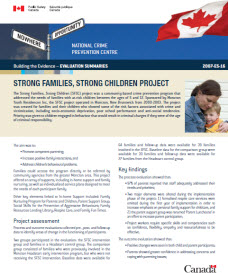
|
Strong Families, Strong Children Project
|
The Strong Families, Strong Children (SFSC) project was a community-based crime prevention program that addressed the needs of families with at-risk children between the ages of 5 and 12.
| 2007-11-01 |

|
The Community Solution to Gang Violence: A Collaborative Community Process and Evaluation Framework
|
This paper provides a model for viewing the work of comprehensive community initiatives, details the process and practice involved in mobilizing and engaging the community to address the issue of gangs, and outlines the evaluation framework used to measure the effectiveness and impact of a community-based and driven approach to prevent youth involvement in gangs.
| 2007-10-12 |

|
Supervising sexual offenders in the community
|
How can community supervision officers tell whether sexual offenders are at risk for reoffending?
| 2007-09-01 |
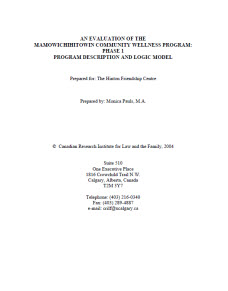
|
An Evaluation of the Mamowichihitowin Community Wellness Program
|
The purpose of this research project was to conduct the first phase of an evaluation of the Mamowichihitowin Community Wellness Program (MCWP) located in Hinton, Alberta.
| 2007-08-16 |

|
Reducing delinquency through family intervention
|
Can family therapy reduce delinquent behaviour?
| 2007-07-01 |

|
The Validity of Risk Assessments for Intimate Partner violence: A Meta-Analysis 2007-07
|
This meta-analysis reviews the predictive accuracy of different approaches and tools that are used to assess the risk of recidivism for male spousal assault offenders.
| 2007-07-01 |
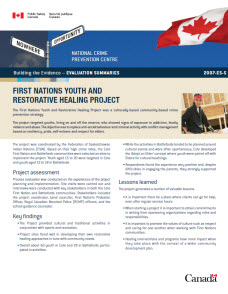
|
First Nations Youth and Restorative Healing Project
|
The First Nations Youth and Restorative Healing Project was a culturally-based community-based crime prevention strategy.
| 2007-06-06 |
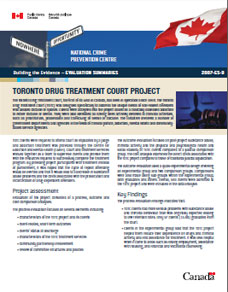
|
Toronto Drug Treatment Court
|
The Toronto Drug Treatment Court, the first of its kind in Canada, has been in operation since 1998.
| 2007-06-06 |

|
Risk-need-responsivity model for offender assessment and rehabilitation 2007-06
|
This paper summarizes the role of the principles in the development of risk assessment instruments. It also explains why some interventions work and others do not.
| 2007-06-01 |

|
Evidence-based crime prevention: Scientific basis, trends, results and implications for Canada
|
Crime prevention policy and practice should be based on solid scientific knowledge and evidence.
| 2007-06-01 |
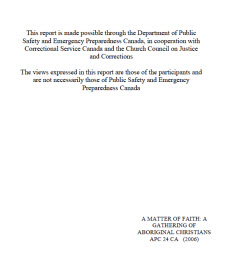
|
A Matter of Faith: a Gathering of Aboriginal Christians
|
This report presents a selection of the wide-ranging views put forward at the Gathering.
| 2007-05-29 |

|
Predicting violent recidivism
|
How well can risk assessment instruments predict violent recidivism?
| 2007-05-01 |

|
Assessing the Utility of Risk Assessment Tools and Personality Measures in the Prediction of Violent Recidivism for Adult Offenders 2007-04
|
The objective of the current study was to conduct a meta-analytic evaluation of the relative utility of risk instruments and other psychological measures as a means of informing the standards of practice for conducting violent risk assessments.
| 2007-04-01 |

|
The Collaborative Outcome Data Committee's Guidelines for the evaluation of sexual offender treatment outcome research
|
The objective of the current study was to conduct a meta-analytic evaluation of the relative utility of risk instruments and other psychological measures as a means of informing the standards of practice for conducting violent risk assessments.
| 2007-04-01 |

|
Banyan Community Services SNAP™ Under-12 Outreach Project
|
The Banyan Community Services SNAP™ Under-12 Outreach Project (BCS SNAP™ ORP) is an ongoing program that started in 2003 in Hamilton, Ontario.
| 2007-04-01 |

|
Boundless Adventures project
|
Boundless Adventures was a crime prevention initiative aimed at high-need, under-resourced families with children aged 2 to 6 years in Ontario.
| 2007-04-01 |

|
Domestic Violence Treatment Option court (DVTO)
|
The Domestic Violence Treatment Option court (DVTO) was created in 2000 as a response to the high rates of domestic violence, the victimization First Nations felt from the criminal justice system and the sense that many victims were not reporting domestic violence to police.
| 2007-04-01 |

|
Downtown Eastside
|
The purpose of the project was to mobilize the Downtown Eastside community and build capacity among residents, agencies, and business representatives to address some of the known risk factors for involvement in crime and victimization.
| 2007-04-01 |

|
HomeFront
|
HomeFront was a four-year initiative in Calgary, Alberta. It consisted of a coordinated community response to address the issue of domestic violence.
| 2007-04-01 |

|
Kids 1st Project
|
The Kids 1st Project was a crime prevention program for children 9 to 11 years old.
| 2007-04-01 |
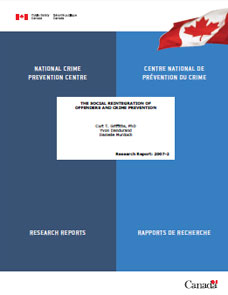
|
The Social Reintegration of Offenders and Crime Prevention
|
Comprehensive crime prevention programs must include effective measures to prevent recidivism and to stop the cycle of failed adaptation by repeat offenders
| 2007-04-01 |

|
Together We Light The Way
|
The Together We Light The Way project was a school-based prevention model implemented in the Durham District School Board Region to respond to the specific needs of children who may engage in anti-social behaviours.
| 2007-04-01 |

|
Youth gang involvement: What are the risk factors?
|
This information sheet is one of a series providing information related to youth gang involvement.
| 2007-04-01 |

|
Youth gangs in Canada: What do we know?
|
This document presents an overview of current knowledge about youth gangs in Canada, including their connections with guns and drugs.
| 2007-04-01 |

|
An Investigation into the Formation and Recruitment Processes of Aboriginal Gangs in Western Canada
|
This report provides a brief literature review of current gang research, including the incorporation of information from documents produced by agencies that work with gang-involved youth.
| 2007-03-19 |

|
Evaluating offender rehabilitation programs
|
How can we tell whether interventions with offenders reduce recidivism?
| 2007-03-01 |

|
Sexual Offender Treatment Outcome Research: CODC Guidelines for Evaluation
|
This document is intended for those seriously interested in research on the effectiveness of treatment for sexual offenders.
| 2007-03-01 |

|
Strategies for Reducing Gun Violence: The Role of Gangs, Drugs and Firearm Accessibility
|
This report on strategies to reduce gun violence begins with a brief overview of recent trends in gun violence with a particular focus on emerging trends and changes in Canada
| 2007-03-01 |

|
Aboriginal Policing Update 2007 - Volume 1, No 1
|
Aboriginal Policing Update 2007 - Volume 1, No 1
| 2007-02-27 |

|
The accuracy of risk prediction for sexual offenders
|
How should we assess the recidivism risk of sexual offenders?
| 2007-01-01 |

|
Restorative justice and offender treatment
|
Can offender treatment services improve the effectiveness of restorative justice interventions?
| 2006-11-01 |

|
Spousal Abuse Counseling Program - Rankin Inlet Manual for Counselors
|
This manual should be considered a tool to be used to guide the counselor in the delivery of group counseling.
| 2006-10-27 |

|
Risk factors for Aboriginal offenders
|
Are risk factors for criminal behaviour similar for Aboriginal and non-Aboriginal offenders?
| 2006-09-01 |

|
Screening for positions of trust with children
|
How can child service organizations limit the risk of sexual abuse?
| 2006-07-01 |

|
Recidivism rates of female sexual offenders
|
How often do female sexual offenders commit new crimes?
| 2006-05-01 |

|
ARCHIVE - Final Report: "Youth, Weapons and Violence in Toronto and Montreal"
|
This report presents research that contributes to knowledge about the inter-relationships of youth, guns and gang violence in Toronto and Montreal.
| 2006-03-31 |

|
Offender assessment and case management
|
How can we improve the link between offender assessment and case management?
| 2006-03-01 |

|
Sexually abusive juveniles
|
Are sexually abusive juveniles different from adult sex offenders?
| 2006-01-01 |

|
Risk assessment of male aboriginal offenders: A 2006 perspective
|
The purpose of this review was three-fold. First, the research on risk factors was reviewed to determine whether risk factors were similar for both Aboriginal and non-Aboriginal male offenders. Second, various risk assessment instruments were examined to determine how well they predicted risk for the male Aboriginal offenders. Third, different perspectives regarding risk assessment of male Aboriginal offenders were presented, commonalities between the views were identified, and recommendations were outlined.
| 2006-01-01 |

|
Working Together to Combat Organized Crime
|
This report provides a brief overview of the scope of serious and organized crime in Canada.
| 2006-01-01 |

|
Identifying and tracking high-risk offenders
|
Is the National Flagging System (NFS) facilitating the early identification and the proper management of those offenders believed to be at a high risk to reoffend violently and/or sexually?
| 2005-11-01 |

|
Bullying prevention in schools
|
Bullying Prevention in Schools is a study undertaken by the NCPC on the subject of school-based anti-bullying programs.
| 2005-11-01 |

|
Bullying prevention in schools: Executive summary
|
Bullying Prevention in Schools: Executive Summary is a summary of a study undertaken by the NCPC that reviewed school-based anti-bullying programs, looking at promising practices, results from NCPC-sponsored projects and recommendations for future work in this area.
| 2005-11-01 |

|
First Steps to stop bullying - Adults helping children aged 4-11
|
First Steps to stop bullying - Adults helping children aged 4-11
| 2005-11-01 |

|
First steps to stop bullying - Adults helping youth aged 12-17
|
First steps to stop bullying - Adults helping youth aged 12-17
| 2005-11-01 |

|
Safe and Sound
|
The Safe and Sound project was undertaken in four Ontario neighbourhoods: two in Waterloo, namely Kingsdale and Sunnydale, as well as Southwood and Christopher-Champlain, in Cambridge.
| 2005-10-01 |

|
Presentence Reports
|
How are Presentence Reports (PSR) used by the courts in sentencing?
| 2005-09-01 |

|
Restorative justice in cases of serious crime
|
Can a restorative justice approach be applied in cases of serious crime?
| 2005-07-01 |

|
Progress in violence risk assessment
|
What have we learned about evaluating the risk of future violence?
| 2005-05-01 |

|
The National Flagging System: Identifying and Responding to High-Risk, Violent Offenders 2005-04
|
The present research was aimed at empirically investigating the effectiveness of this policy initiative in identifying and responding to potentially dangerous offenders. Specifically, the profile of 256 flagged male offenders was compared with the profile of 97 known high-risk, violent offenders (i.e., Dangerous Offenders and Detention Failures).
| 2005-04-01 |

|
Effective correctional treatment
|
How much treatment is required to reduce reoffending?
| 2005-03-01 |

|
Presentence Reports in Canada 2005-03
|
The present study obtained the views of judges, probation officers, Crown attorneys and defence counsel on the use and value of PSRs. Participants were chosen from a site in each Canadian province and territory.
| 2005-03-01 |

|
Evaluation of the Collaborative Justice Project: A Restorative Justice Program for Serious Crime 2005-02
|
The goals of this evaluation were threefold: (1) to determine whether a restorative approach can be applied in cases of serious crime at the pre-sentence stage of the criminal justice system, (2) to determine whether the CJP successfully met its mandate and program goals, and (3) to expand the empirical base regarding restorative justice research.
| 2005-02-01 |

|
Accreditation standards for correctional programs
|
How can you tell whether a correctional program is likely to reduce reoffending?
| 2005-01-01 |

|
The Validity of Static-99 with Older Sexual Offenders 2005-01
|
Using data from 8 samples (combined size of 3,425 sexual offenders), the present study found that older offenders had lower Static-99 scores than younger offenders and that Static-99 was moderately accurate in estimating relative recidivism risk in all age groups.
| 2005-01-01 |

|
Public confidence in the criminal justice system
|
What is the level of confidence that Canadians have in the criminal justice system?
| 2004-11-01 |

|
Specialized risk assessment for violence
|
Do offender risk scales especially designed to predict violent re-offending perform better than scales for predicting general re-offending?
| 2004-09-01 |
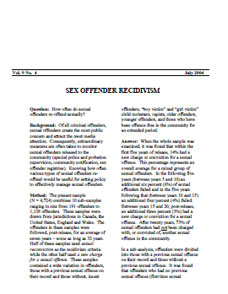
|
Sex offender recidivism
|
How often do sexual offenders re-offend sexually?
| 2004-07-01 |

|
Sexual abuse in the Catholic church
|
Are priests who abuse children different from other child molesters?
| 2004-05-01 |
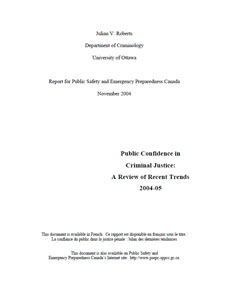
|
Public Confidence in Criminal Justice: A Review of Recent Trends 2004-05
|
The purpose of this report is to summarize recent trends regarding public confidence in criminal justice in Canada.
| 2004-05-01 |

|
Sex Offender Recidivism: A Simple Question
|
This study examines sexual recidivism, as expressed by new charges or convictions for sexual offences, using the data from 10 follow-up studies of adult male sexual offenders (combined sample of 4,724).
| 2004-05-01 |

|
Risk Assessment For General Assault And Partner Abusers 2004-04
|
The present report describes two studies that evaluated two specialized assessment tools: the Secondary Risk Assessment for General Assault (SRA-GA) and the Secondary Risk Assessment for Partner Abusers (SRA-PA).
| 2004-04-01 |

|
Predicting re-offending among sexual offenders
|
Which sexual offenders are most likely to re-offend?
| 2004-03-01 |

|
The supervision of offenders in the community
|
How are offenders supervised while they are in the community?
| 2004-03-01 |
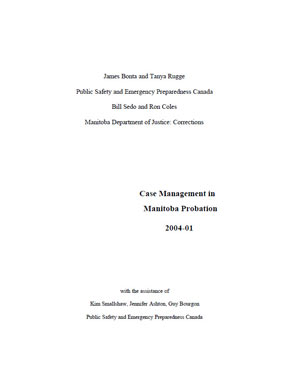
|
Case Management in Manitoba Probation 2004-01
|
In general, the study provides a snapshot of present practices in community supervision and points to areas of improvement. With training and support, probation officers can become more effective agents of change.
| 2004-01-01 |

|
Biidaaban: The Mnjikaning community healing model
|
The purpose of this research, therefore, is to provide a holistic picture of Biidaaban, the Mnjikaning Community Healing Strategy, in Mnjikaning First Nation that includes a description of the community, its healing process and its value to the community
| 2003-12-01 |

|
Cost-benefit analysis of a community healing process
|
Are Aboriginal community healing processes cost-effective alternatives to the traditional criminal justice process?
| 2003-11-01 |

|
Sexual offender empathy deficits
|
Do sexual offenders lack empathy for their victims?
| 2003-09-01 |

|
The recidivism of federal offenders
|
After release from federal penitentiaries, how many offenders re-offend?
| 2003-07-01 |

|
Psychological deviance among child molesters
|
Does psychological deviance predict the recidivism of child molesters?
| 2003-05-01 |

|
The content of sexual offender risk scales
|
How can we improve risk scales for sexual offenders?
| 2003-03-01 |

|
The Reconviction Rate of Federal Offenders 2003-02
|
The present study was conducted as part of the mandate of the Solicitor General Portfolio Corrections Statistics Committee to provide the general public and professionals basic statistical information on corrections and conditional release.
| 2003-02-01 |

|
Restorative justice and recidivism
|
Can restorative justice programs influence offender recidivism?
| 2003-01-01 |

|
Notes on the development of Static-2002 2003-01
|
This paper describes the development of a new risk scale for sexual offenders, Static-2002.
| 2003-01-01 |

|
Mapping The Healing Journey
|
The final report of a First Nation Research Project on Healing in Canadian Aboriginal Communities
| 2002-12-01 |

|
Choices and consequences - Offenders as a Resource For Crime Prevention
|
What follows is a collection of thoughts on the topic of how Aboriginal offenders may offer their talents to keep young people from coming into conflict with the justice system. It includes background work that has been done in this area as well as descriptions of some fine programs that no longer exist and one that continues.
| 2002-12-01 |

|
Guidelines for offender risk assessment
|
How does the research literature offer to guide the selection and use of offender risk assessment instruments?
| 2002-11-01 |

|
Restorative justice: promising beginnings
|
What do we know about the impact of restorative justice programs in Canada?
| 2002-09-01 |

|
The effectiveness of treatment for sexual offenders
|
Does treatment keep sexual offenders from reoffending?
| 2002-07-01 |

|
The effects of punishment on recidivism
|
Does punishment of offenders reduce their re-offending?
| 2002-05-01 |

|
Offender risk assessments: Approaches to their development
|
How do researchers approach the development of offender risk scales?
| 2002-03-01 |

|
Translating research into practice: Offender Risk Assessment
|
What is involved when correctional systems implement offender risk scales that are developed by researchers?
| 2002-01-01 |
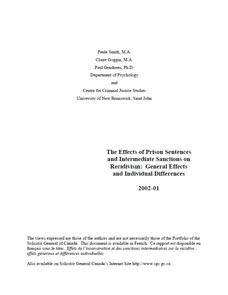
|
The Effects of Prison Sentences and Intermediate Sanctions on Recidivism: General Effects and Individual Differences
|
The purpose of this investigation was to update the results from these previous reports and to examine the effects of sanctions for juveniles, females, and minority groups.
| 2002-01-01 |

|
A Cost-Benefit Analysis of Hollow Water's Community Holistic Circle Healing Process
|
A Cost-Benefit Analysis of Hollow Water's Community Holistic Circle Healing Process
| 2001-12-01 |

|
Public fear of crime and perceptions of the criminal justice system: A review of recent trends
|
How does fear of crime relate to attitudes toward the criminal justice system?
| 2001-11-01 |
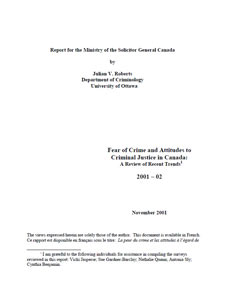
|
Fear of Crime and Attitudes to Criminal Justice in Canada: A Review of Recent Trends 2001-02
|
This report summarizes recent trends with respect to fear of crime and attitudes to criminal justice in Canada.
| 2001-11-01 |
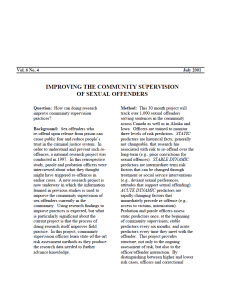
|
Improving the community supervision of sexual offenders
|
How can doing research improve community supervision practices?
| 2001-07-01 |

|
National Consultation with Victims of Crime
|
In this report, I am pleased to present the main issues raised during a recent national consultation with victims of crime.
| 2001-07-01 |

|
Age and sexual recidivism
|
Does the risk of sexual offending decrease with age?
| 2001-05-01 |

|
High-Risk Offenders - A Handbook for Criminal Justice Professionals
|
This handbook describes the principal legislative and policy options developed by the Government of Canada and available to members of Canada's criminal justice system for dealing with High-Risk offenders.
| 2001-05-01 |

|
A statistical overview of federal corrections and conditional releases
|
What is the statistical picture of federal corrections and conditional release in Canada?
| 2001-03-01 |

|
Policy relevant correctional research
|
How does correctional research influence public policy?
| 2001-01-01 |
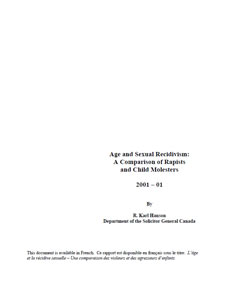
|
Age and Sexual Recidivism: A Comparison of Rapists and Child Molesters
|
This study examined the relationship of age to sexual recidivism using data from 10 follow-up studies of adult male sexual offenders (combined sample of 4,673).
| 2001-01-01 |

|
Predicting Recidivism Among Abusive Men
|
What factors are associated with continued violence among men who have abused their intimate partners?
| 2000-11-01 |

|
Treating the higher risk offender
|
Can treatment be effective with higher risk offenders?
| 2000-09-01 |

|
Corrections Population Report - Fourth Edition for the Federal/Provincial/Territorial Ministers Responsible for Justice
|
The current report is designed to conclude the series and to provide a status report on progress and developments over the past 5 years.
| 2000-09-01 |

|
Treatment for abusive men
|
What type of treatment works best with abusive men?
| 2000-07-01 |

|
Predicting Recidivism Among Male Batterers
|
The present study examined recidivism risk factors in a sample of 320 male batterers.
| 2000-06-01 |

|
Adolescent female aggression
|
Is the aggression of adolescent girls different from the aggression of adolescent boys?
| 2000-05-01 |

|
A Multi-Site Study of Treatment for Abusive Men 2000-05
|
This study examined the relative effectiveness of four treatment programs for abusive men (n = 230).
| 2000-05-01 |

|
Female Adolescent Aggression: A Review of the Literature and the Correlates of Aggression
|
This review of the literature focuses on aggression and girls.
| 2000-04-01 |

|
Pardoned sex offenders in Canada: What do we know?
|
How many sex offenders have been pardoned under the Criminal Records Act and how many reoffend sexually?
| 2000-03-01 |

|
Pardoned Offenders in Canada: A Statistical Analysis 2000-02
|
Pardoned Offenders in Canada: A Statistical Analysis 2000-02
| 2000-03-01 |

|
Measuring the change in risk posed by sex offenders
|
How can we evaluate changes in risk levels for sex offenders?
| 2000-01-01 |

|
The Sex Offender Need Assessment Rating (SONAR): A Method for Measuring Change in Risk Levels 2000-1
|
The current study examines how well the dynamic risk factors identified in the Hanson and Harris (1998) study can be organised into a structured risk assessment.
| 2000-01-01 |

|
The effect of prison on criminal behavior
|
Does increasing the length of time in prison reduce the criminal behaviour of offenders?
| 1999-11-01 |

|
Brief risk scales for the prediction of sex offence recidivism
|
How well can brief, structured risk scales predict sex offence recidivism?
| 1999-11-01 |

|
Corrections research in Canada: Taking stock
|
What have been the most significant developments in corrections research in Canada during the past twenty years?
| 1999-07-01 |

|
The electronic monitoring of offenders
|
Does electronic monitoring reduce the criminal behaviour of offenders?
| 1999-05-01 |

|
Electronic Monitoring in Canada
|
The present evaluation not only used comparison groups of inmates and probationers, but also introduced controls for offender risk. Thus, we were in a position to investigate the impact of EM, and treatment, on offender recidivism.
| 1999-05-01 |

|
Approaches to offender risk assessment: static vs dynamic
|
Does it matter how we make assessments of offender risk?
| 1999-03-01 |
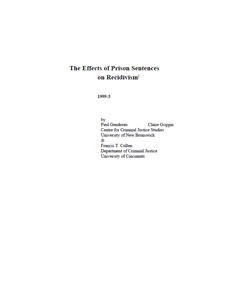
|
The Effects of Prison Sentences on Recidivism
|
The Effects of Prison Sentences on Recidivism
| 1999-03-01 |

|
Static 99: Improving Actuarial Risk Assessments for Sex Offenders
|
The purpose of the present study was to compare the predictive accuracy of two of these actuarial schemes: the RRASOR (Hanson, 1997) and the SACJ (see Grubin, 1998).
| 1999-02-01 |

|
Measuring the extent of crime
|
Is crime on the increase?
| 1999-01-01 |

|
Restorative justice: An alternative to traditional criminal justice
|
Can restorative justice offer a practical alternative to traditional criminal justice processing?
| 1998-11-01 |

|
Characteristics of abusive men
|
What sort of man assaults his partner?
| 1998-09-01 |

|
Triggers of sexual offence recidivism
|
When are sexual offenders are at risk to re-offend?
| 1998-07-01 |

|
Mentally disordered offenders
|
How dangerous are mentally disordered offenders?
| 1998-05-01 |

|
Assessing the risk of re-offending among Aboriginal offenders
|
Do risk factors for recidivism differ between Aboriginal and non-Aboriginal offenders?
| 1998-03-01 |

|
Adult offender diversion programs
|
What do we know about the effectiveness of adult offender diversion programs?
| 1998-01-01 |

|
Dynamic Predictors Of Sexual Recidivism
|
Carefully monitoring the risk indicators identified in this study should help officers to provide graduated and responsive interventions well before the point of no return.
| 1998-01-01 |

|
The Four Circles of Hollow Water
|
The purpose of this collection is to explore the Hollow Water experience; to see the community in the context of its culture and of Canadian society as a whole; to hear what others have to say about them, and what they have to say about themselves.
| 1997-12-01 |
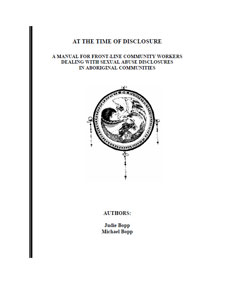
|
At the Time of Disclosure a Manual for Front-Line Community Workers Dealing with Sexual Abuse Disclosures in Aboriginal Communities
|
This manual has been developed to assist front-line community workers, especially those in aboriginal communities, deal more effectively with issues around sexual abuse disclosures.
| 1997-12-01 |

|
Female offender recidivism
|
What are the risk factors associated with female offenders' continuation in crime?
| 1997-11-01 |

|
Social networks of sexual offenders
|
Do sexual offenders know other sexual offenders?
| 1997-09-01 |

|
An alternative model for treating abusive men
|
Are there non-traditional ways of treating male batterers?
| 1997-07-01 |
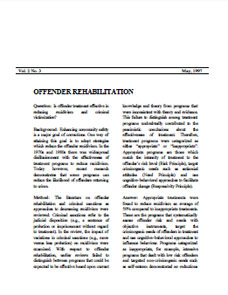
|
Offender rehabilitation
|
Is offender treatment effective in reducing recidivism and criminal victimization?
| 1997-05-01 |

|
The Development of a Brief Actuarial Risk Scale for Sexual Offense Recidivism 1997-04
|
The present study used data from seven different followup studies to develop a brief, actuarial risk scale, which was then replicated on an additional independent sample (total sample size of 2,592).
| 1997-04-01 |

|
Predicting adult offender recidivism
|
What are the best predictors of offender recidivism and, secondly, what type of actuarial measures are best suited for this purpose?
| 1997-03-01 |

|
Predictors of sex offence recidivism
|
How can we tell which sexual offenders are at high risk to re-offend?
| 1997-01-01 |

|
Offender Rehabilitation: From Research to Practice 1997-01
|
This paper attempts to translate into practice what we know from the research on effective interventions with offenders.
| 1997-01-01 |

|
Examining Aboriginal Corrections in Canada
|
This document provides information gathered though surveys, analyses of quantitative data and a review of current literature and research about the state of aboriginal corrections.
| 1996-12-01 |

|
Explaining aboriginal corrections
|
What is the state of knowledge in aboriginal corrections and what are the most critical policy and program issues?
| 1996-11-01 |

|
Dangerous offenders in Canada
|
Are the Dangerous Offender provisions of the Criminal Code of Canada actually targeting high risk violent offenders?
| 1996-09-01 |
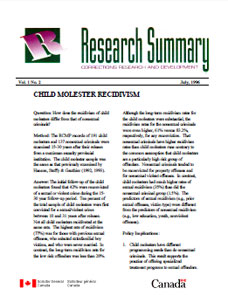
|
Child molester recidivism
|
How does the recidivism of child molesters differ from that of nonsexual criminals?
| 1996-07-01 |

|
Prediction of recidivism
|
Is the Statistical Information on Recidivism (SIR) scale still a valid measure of offender risk?
| 1996-05-01 |

|
Predictors of Sexual Offender Recidivism: a Meta-Analysis 1996-04
|
This review provides a quantitative summary of recidivism risk factors for sexual offenders.
| 1996-04-01 |

|
Conquest By Law
|
I offer the original manuscript in the spirit in which it was written: an account of the original aboriginal justice system and what happened when white men arrived with their laws and guns. It will hopefully serve as a useful reference and an account of a shameful part of Canadian history, the record of the pain and injustice that was suffered by the First Nations.
| 1994-12-01 |

|
Understanding The Role of Healing in Aboriginal Communities
|
The report attempts to develop a common understanding of "healing" among Aboriginal community members and non-Aboriginal government representatives.
| 1994-12-01 |

|
Selected Urban Aboriginal Correctional Programs In Canada: A Program Review
|
This is a descriptive report on seven selected urban Aboriginal correctional programs in Canada, chosen to provide an overview of the range of programs and services in the area.
| 1994-12-01 |

|
Community Development & Research
|
This report is the result of an intensive, two-day session held in August, 1994.
| 1994-12-01 |